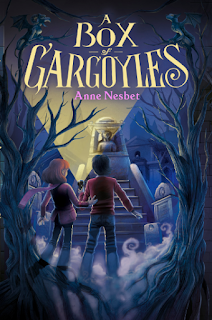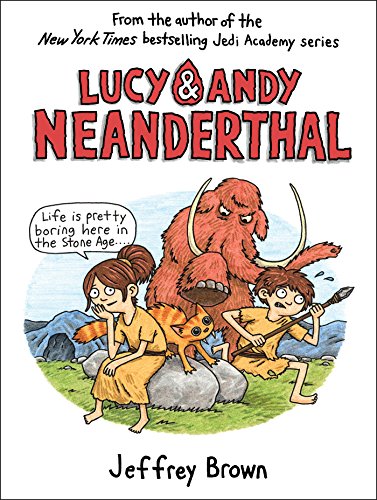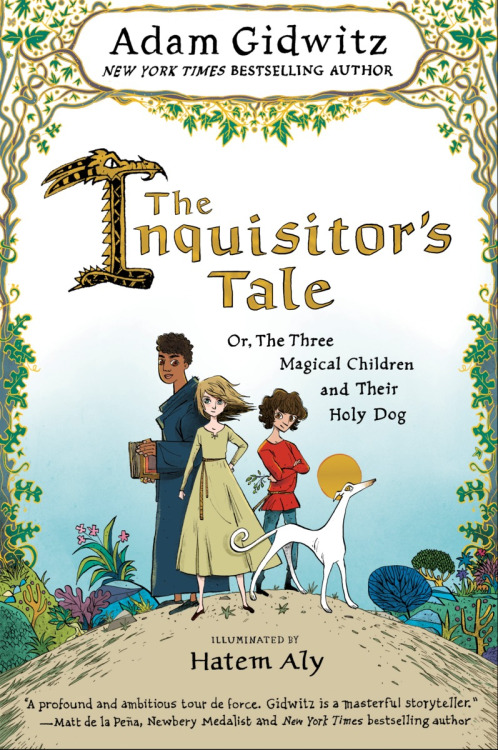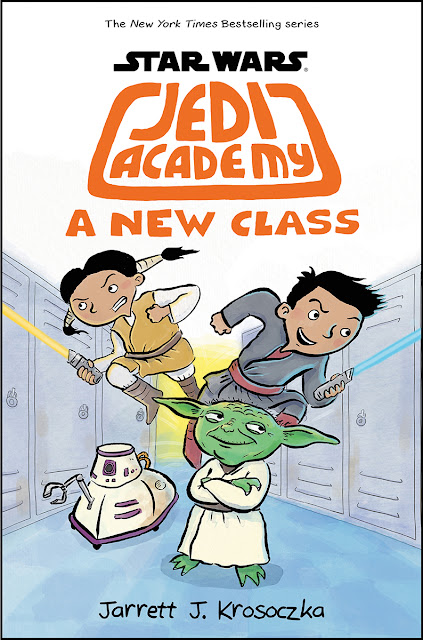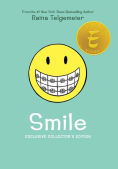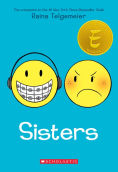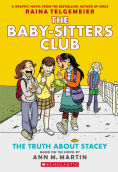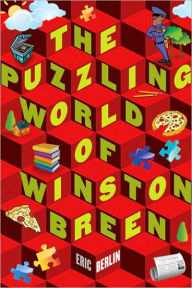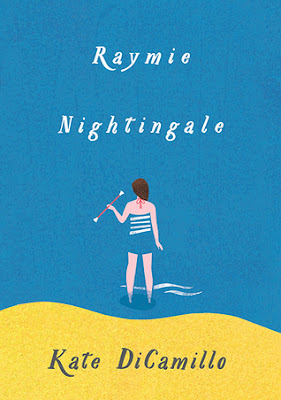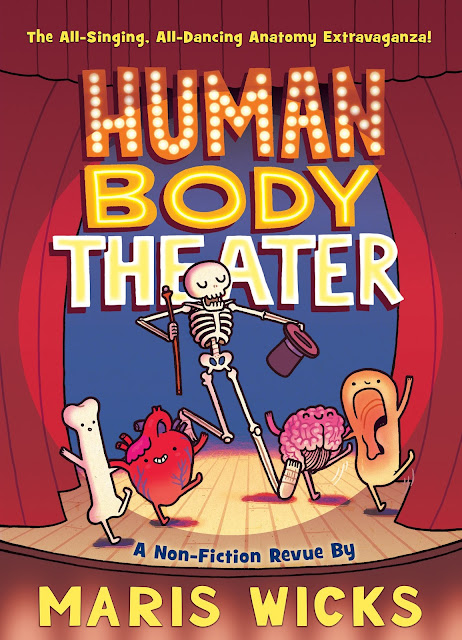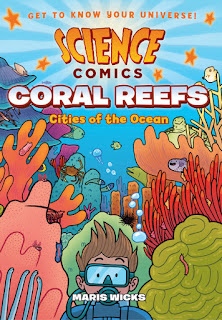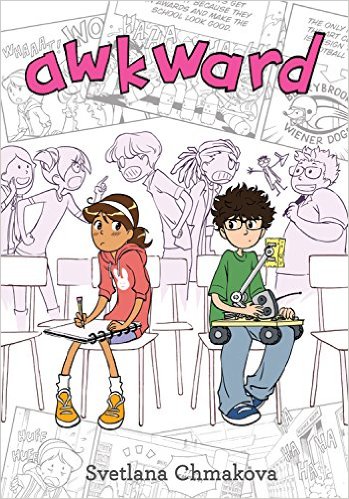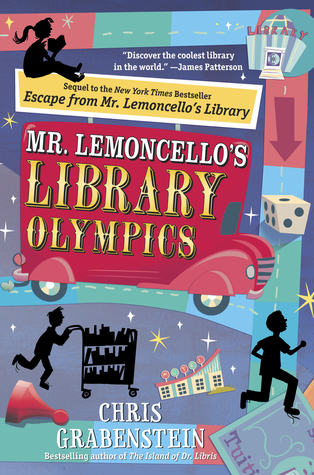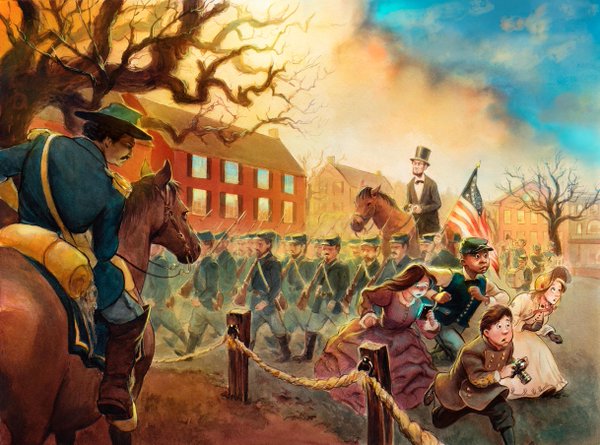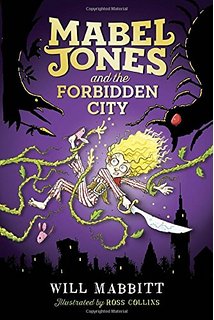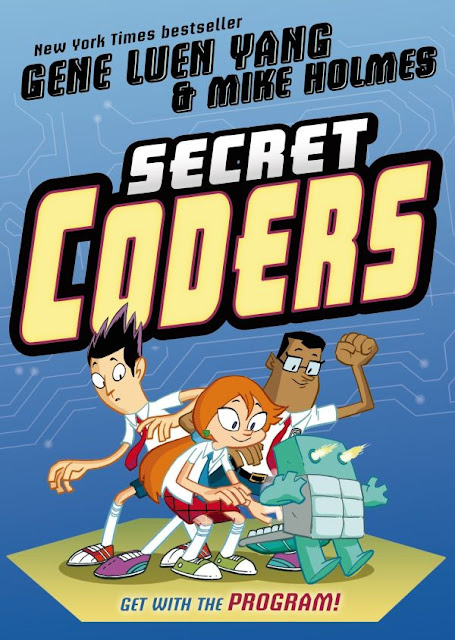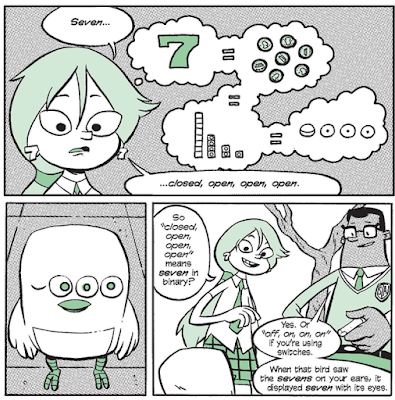new posts in all blogs
Viewing: Blog Posts Tagged with: Reading Level 4, Most Recent at Top [Help]
Results 1 - 25 of 195
How to use this Page
You are viewing the most recent posts tagged with the words: Reading Level 4 in the JacketFlap blog reader. What is a tag? Think of a tag as a keyword or category label. Tags can both help you find posts on JacketFlap.com as well as provide an easy way for you to "remember" and classify posts for later recall. Try adding a tag yourself by clicking "Add a tag" below a post's header. Scroll down through the list of Recent Posts in the left column and click on a post title that sounds interesting. You can view all posts from a specific blog by clicking the Blog name in the right column, or you can click a 'More Posts from this Blog' link in any individual post.
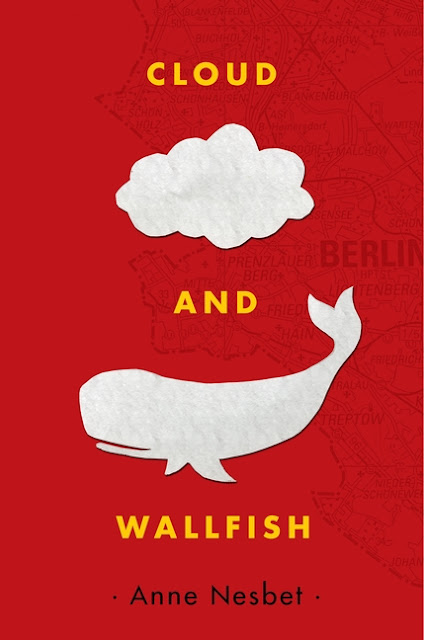
I reviewed and really enjoyed Anne Nesbet's debut novel, The Cabinet of Earth. It was exciting to read a middle grade fantasy novel set in Paris and I found the magic that Nesbet created for this story exciting and out of the ordinary. Nesbet followed with A Box of Gargoyles, a companion to her first book, then The Wrinkled Crown, another fantasy with the feel of a traditional fairy tale, albeit one with political undertones. It surprised me to find that Nesbet's new book, Cloud and Wallfish, is set in East Germany in 1989 and centers around the hard won friendship between an American boy with a paralyzing stutter and a curious girl who has been sent to live with her grandmother. Like what I imagine life in the German Democratic Republic prior to the fall of the Berlin Wall must have been like, Cloud and Wallfish is a quiet, secretive book that requests patience from readers. This patience will be rewarded, like the page turn that reveals the meaning to the title of this marvelous book, but some questions will never be answered.
Cloud and Wallfish begins in Oasis, Virginia in May of 1989. Noah Keller has almost finished fifth grade when his parents pick him up from school and completely turn his life upside down. Everything with his name on it is thrown into a trashcan at a rest stop on their way to the airport. They are headed to East Berlin, where Noah's mother has been given the opportunity to study the educational system in East Germany and finish her doctoral dissertation titled, "Differential Approaches to Elementary Education for Children with Special Speech-Production Impediments in East and West." This dissertation is especially personal for Noah and his mother because Noah stutters and has often been a guinea pig for his mother and her research. Noah also has a photographic memory, although he has not revealed this ability to his parents.
Noah's mother gives him a list of nine rules that he must adhere to strictly now that their "adventure" has begun, the first of which is, "They will always be listening and often be watching. Don't forget that." She also tells him that they are all changing their names, handing him a photo album filled with "memories" from a city they never lived in. Noah's dad also tells him that he was born in November and not March as he had always believed, sending him spiraling even further. Nesbet, by way of Noah's father, helps Noah cope with finding out that he isn't the person he thought he was, and that he is also being required to become a new person, in a humorously philosophical way that made me stop and think about identity,
Names change all the time. Some people change names when they get married, Some people write books under a pseudonym. Some people just always wanted to be called Rainbow Stormchaser, and one day they decide to make it so. Some people emerge from their wild teenage years and decide it's time to settle down to a quiet life in Oasis, Virginia, under different names entirely -
As an adult reading Cloud and Wallfish, there were so many moments that made me stop and think, and turn to Wikipedia, or my husband who is a history teacher and who also, like Nesbet, visited East Berlin as an exchange student (in fact, Nesbet, who is a professor at University of California Berkeley returned to the GDR in 1989 to work on her own dissertation). It was clear to me from the start that one or both of Noah's parents are spies (although Noah's stay-at-home dad insists that he is writing a novel about a mink farmer, he even puts locks his manuscript in the safe in their East German apartment every night), but I hope that young readers will come to this realization over the course of the novel along with Noah as he comes to suspect this himself.
Once in East Berlin, Noah's (now Jonah Brown) life comes to a grinding halt. Not only does he have to adhere to the nine rules, almost all of which include some form of not talking to anyone at any time, he is not allowed to go to school. Things do look up when he meets the girl living downstairs. Claudia, who is staying with her grandmother while her parents visit Hungary, is kept from talking to him, but she does get the chance to tell him that they are both changelings, strangers in this world and needing to get back to where they came from before they are forgotten. The two find their own coded ways to communicate, in the middle of country that is rife with codes and secret communications. One of my favorite, unforgettable things in Cloud and Wallfish is a communication the two share as they pass a map of Berlin back and forth. On this map, West Berlin is a blank, white blob amidst the streest of East Berlin and the two slowly begin drawing the intricate world of the changelings that they need to return to in this space.
The true climax of Cloud and Wallfish comes almost at the end of the novel, but "Secret Files" that Nesbet includes at the after each chapter (which are really non-fiction glimpses into this time in East Germany, with translations of newspaper articles and speeches and more, illuminating further the strange dystopian world that existed in Europe, in my lifetime) help to build the tension. I don't want to give too much away, but a tragedy with Claudia's parents and a secret revealed to Noah propels the two children into a dangerous situation just before the fall of the Berlin Wall. Nesbet's epilogue, which visits Claudia some years later, had me tearing up, in a good way.
Cloud and Wallfish is an amazing book that prompted me to learn more about the world that I live in. It is also a book that will require perseverance and dedication from readers, but also one that will reward this hard work. I hope that teachers and parents will embrace Cloud and Wallfish and read it out loud, a really great way to hook kids on a book they might not pick up or a book they might not stick with. My twelve-year-old son has heard me and my husband talking about this book and I think he is almost ready to give it a go, but of course I can't suggest that he read it...
Another fantastic book set in East Germany, 1961, beginning just as the wall goes up:
More books by Anne Nesbet
Source: Review Copy
I absolutely love the concept for Julius Zebra: Rumble with the Romans! by the genius Gary Northfield! If I had to nutshell it, I'd say, think Terry Deary's Horrible Histories meets 13 Story Tree House. Julius is a hilarious character living in a time period that makes for some crazy adventures. Northfield layers in the history, from using Roman numerals for the page numbers to giving characters Roman names, as well as the names of famous Romans, and using Latin and the historically accurate names for the fights, fighters, arenas and more that appear in this book. There is even a tutorial on how to read Roman numerals and a glossary at the back of the book!
 Julius Zebra: Rumble with the Romans! begins in African plains at a watering hole, called the Lake of Doom by Julius, that he does not want to be at. Actually, the book begins with Julius schooling readers about what zebras are really like, burps and all. It stinks (an illustration shows a yak pooping in the lake) is "sooo boring!" and presents the constant danger of being eaten. Wandering off from the Lake of Doom and trying to outrun a lion, Julius and helpful but annoying warthog named Cornelius and . . . a lion.
Julius Zebra: Rumble with the Romans! begins in African plains at a watering hole, called the Lake of Doom by Julius, that he does not want to be at. Actually, the book begins with Julius schooling readers about what zebras are really like, burps and all. It stinks (an illustration shows a yak pooping in the lake) is "sooo boring!" and presents the constant danger of being eaten. Wandering off from the Lake of Doom and trying to outrun a lion, Julius and helpful but annoying warthog named Cornelius and . . . a lion.

Never fear, it's not as bad as it seems! The naive Julius hears talk of a circus and caravans, of juggling monkeys and bears dancing with ostriches and he gets pretty excited. Unfortunately, the circus he is going to is the Circus Maximus (well, actually the Colosseum) and he is going to be performing in it, not watching it. This is such a fantastic conceit and I really hope that kids take to this kind of mash-up of history and humor so that Julius Zebra spawns imitators the way Diary of a Wimpy Kid has.
 Instead of losing his life to gladiators in the ring, in an effort to keep himself from becoming "someone's fancy carpet," Julius grabs a sword and saves his tail, winning over the crowd and the Emperor, Hadrian. Julius earns himself a spot in the gladiatorial championship in 30 days that will celebrate Hadrian's birthday. As the new "People's Champion," he will get to fight for his freedom, and fame and wealth. Julius, Cornelius and a gang of animals, including Lucia, a vegetarian crocodile, Pliny the mouse, Milus the lion, Rufus a giraffe and Felix, a gazelle, begin training for the battle and also for escape. I don't want to give away the ending, but there is a second book in this series...
Instead of losing his life to gladiators in the ring, in an effort to keep himself from becoming "someone's fancy carpet," Julius grabs a sword and saves his tail, winning over the crowd and the Emperor, Hadrian. Julius earns himself a spot in the gladiatorial championship in 30 days that will celebrate Hadrian's birthday. As the new "People's Champion," he will get to fight for his freedom, and fame and wealth. Julius, Cornelius and a gang of animals, including Lucia, a vegetarian crocodile, Pliny the mouse, Milus the lion, Rufus a giraffe and Felix, a gazelle, begin training for the battle and also for escape. I don't want to give away the ending, but there is a second book in this series...
Source: Review Copy
Patricia MacLachlan is a big name in kid's books. Author of the Newbery winner, Sarah Plain and Tall, a classroom staple, as well as many other novels and picture books, I have reviewed only two of her books. The title of her newest book, The Poet's Dog, hooked me immediately. As did the length of the book. As a librarian at a school where the majority of students are English Language learners who are not reading at grade level, short books like this give them a sense of accomplishment needed to persevere with longer books. As an adult reader, I found The Poet's Dog to be alternately charming and frustrating, not sure what to make of this book. In the end, I decided to read it as a fairy tale and that helped quiet the the questioning voices in my head, allowing me to enjoy MacLachlan's book as I know young readers will.
The Poet's Dog begins with a haiku-like verse, "Dogs speak words/ But only poets/ And children/ Hear." This is the magical premise that sustains the story of Nickel and Flora, siblings lost in a snowstorm who are rescued by Teddy, the dog of the title. Teddy guides the two back to a cabin in the woods belonging to Sylvan, the poet. Slowly, over days, Teddy tells the children about Sylvan, who rescued him from the pound, and the children tell Teddy about the car stuck in the snowbank and their mother leaving to get help. Teddy tells the children about the poetry class held in the cabin and his love of the The Ox-Cart Man, a Caldecott winning picture book written by Pulitzer prize winning poet, Donald Hall, which he hears as a poem. Sylvan becomes ill and Ellie, a student of his, gets him to the doctor and, along with Teddy, becomes heir to his estate when he dies. Teddy refuses to leave the cabin, which is how he is able to rescue the children and keep them safe, but off the grid, until the storm clears.
Like siblings in a fairy tale, Nickel and Flora deal marvelously with the challenges they encounter. They make a fire and tend to it, get wood from the shed and cook with the provisions left in the pantry. Taking the role of cook, Flora explains, "It's not because I'm a girl that I cook. I like it. It's in the herbs. Like science. When I grow up and have twenty-seven cats and dogs and become a horse trainer, I will have a large collection of herbs." Nickel writes in a notebook, sharing his view of life snowed in at the cabin. Teddy says his writing is, "funny, sly, and sometimes poignant. Sylvan taught me the word poignant." Sylvan thinks that poignancy "may be the most important thing in poetry."
And, The Poet's Dog is definitely poignant. Teddy, who, it is revealed, is an Irish Wolfhound, is clearly a reliable caretaker for Nickel and Flora and readers will never worry about their eventual rescue. But, readers will begin to worry about Teddy and what will become of him. Just before Sylvan dies, he tells Teddy that he hopes he will "find a jewel or two." This proves to be a prophetic little mystery that is solved by the (happy) end of the story. So what did I find frustrating about The Poet's Dog? I think I made the mistake of not reading it as a fairy tale from the start, which left me worried and frustrated when I realized that Nickel and Flora's parents must be wild with worry upon realizing they have left the car stuck in the snow bank and that there would be no way they wouldn't be found sooner. I went into this book not realizing that I needed a willing suspension of disbelief, despite the poem at the start! I know that I will return to this book and read it again, maybe even out loud to students. It is magical in the best way, because it's about the magic of words and writing and that, even with a willing suspension of disbelief, is poignant.
One note that I feel bears repeating: I often reading other reviews of books before writing my own, to see what others are thinking and to find a perspective other than my own. I often read the reviews at Kirkus, an industry magazine. In the last year or so, every review (of children's books) makes note of the color of the characters in the book. The review of The Poet's Dog alerted me to the fact that, on the jacket art, the siblings appear to be brown skinned children with black hair while the text describes Nickel as "having blond hair, implying whiteness." Miscue on the part of the artist, Kenard Pak or calculated choice on the part of the art director and editor?
Source: Review Copy
 Jeffrey Brown is the author of the first three fantastic Jedi Academy books, as well as many other hilarious books in which Darth Vader copes with hand-son fatherhood. Now, following another passion of his, he has created a graphic novel series Lucy & Andy Neanderthal, featuring siblings, Lucy and Andy, their clan, and some prehistoric creatures.
Jeffrey Brown is the author of the first three fantastic Jedi Academy books, as well as many other hilarious books in which Darth Vader copes with hand-son fatherhood. Now, following another passion of his, he has created a graphic novel series Lucy & Andy Neanderthal, featuring siblings, Lucy and Andy, their clan, and some prehistoric creatures.
 If you have read any of Brown's other books, then you know he is fantastic when it comes to creating engaging characters. Although I came of age with it, I'm not a fan of Star Wars, yet I found Brown's Jedi Academy books completely enthralling precisely because of the characters he populated this world with. In Lucy & Andy Neanderthal, we meet the tween siblings, their parents, Mr. and Mrs. Luba, and their baby brother Danny. Margaret and Phil, teens who are part of the clan, and the creaky old Mr. Daryl. As the older sister, Lucy can seem like a know-it-all, at least to Andy. In a funny twist, Brown gives Lucy some insights beyond her era, causing the other kids to think she's weird.
If you have read any of Brown's other books, then you know he is fantastic when it comes to creating engaging characters. Although I came of age with it, I'm not a fan of Star Wars, yet I found Brown's Jedi Academy books completely enthralling precisely because of the characters he populated this world with. In Lucy & Andy Neanderthal, we meet the tween siblings, their parents, Mr. and Mrs. Luba, and their baby brother Danny. Margaret and Phil, teens who are part of the clan, and the creaky old Mr. Daryl. As the older sister, Lucy can seem like a know-it-all, at least to Andy. In a funny twist, Brown gives Lucy some insights beyond her era, causing the other kids to think she's weird.
Brown includes two anthropologists, Pam and Eric, in Lucy & Andy Neanderthal. The scientists occasionally appear to share facts about life 40,000 years ago in the Stone Age as well as to let readers know when aspects of Brown's book might not be scientifically accurate, starting with Tiny, Lucy and Andy's pet cat. One thing I really love about the information that Pam and Eric share are the illustrations that accompany them. Brown shows readers what actual anthropologists might see when they are at a dig site, impressing upon readers that what we know scientifically comes from finding the remains of these early humans and their civilization, something somewhat abstract that could elude them.

In this first book in the series, readers see Lucy and Andy and their clan as they hunt a wooly mammoth, with the violence of the kill off the page. We see Lucy creating some cave art on a rainy day with some very funny hijinks and critiques from the adults of the clan. In another chapter Andy's toothache ends with an explanation from Pam and Eric on Neanderthal health care, of the lack thereof. Finding the remains of a wooly mammoth leads to a chapter on Neanderthal clothing and how it was made, which is important as winter approaches. As Lucy & Andy Neanderthal draws to a close, the clan encounters another group of people who seem a bit more civilized. I can't wait to see what happens in the next book as winter sets in!
Source: Purchased
This summer, I discovered that Alexis Deacon, picture book illustrator, author and frequent collaborator with another favorite of mine, Viviane Schwarz, had created Geis, a graphic novel that was already on sale in the UK. I waited patiently for it to go on sale here and, when I finally got to read Geis, I was surprised, enthralled and left breathless by the beauty of the illustrations, the rich world building and the fast pace of the story. I was so sad to read the end of Geis, but, I realized half way into it that it is a trilogy, so there is more to come!

Geis begins with a definition of the word "geis," pronounced "gesh," which is a Gaelic word for a taboo or curse, "like a spell that cannot be broken and certain rules must be obeyed." In an unnamed world that is reminiscent of a Bruegel painting, the Great Chief Matarka is dying without leaving an heir. Fifty people, including the Grand Wizard, the High Priest, the Chief Judge and the Lord Chamberlain have been called to her death bed. Among them is Io, the young daughter of the Kite Lord. Matarka has devised a contest that will determine who will take her place, but Niope, an evil sorceress, using Death Magic, has taken control of the event and tricked the fifty attendees into signing their names to a cursed parchment.


The fifty attendees are hurtled to various corners of the realm by the sorceress and must return to the death chamber to prove their worthiness. Io is the first to return where she learns the horrible truth of the geis from the sorceress. Nemas is next and together, the two know the truth of the challenge the fifty souls face but are not allowed to speak of it. When they do, the curse renders them speechless. They learn that they have until the next sunrise to leave the castle and return for a challenge that will leave all but one of them dead. As Io and Nemas prepare for this battle, we see others facing their fates, some of which are horrific, with bravery and cowardice, together and alone.

Geis is over almost as soon as it starts, yet you reach the final page of this graphic novel feeling like you have been gone for much longer. This is in large part due to Deacon's amazing illustrations and masterful world building. I was reminded immediately of the work of Maurice Sendak, some of which I have shared below. Io proves to be a young but brave and moral hero, struggling to survive in a world that no longer makes sense. I can't wait to see how she faces her next challenge!
Source: Purchased
In 2010, A Tale Dark and Grimm the debut novel by Adam Gidwitz, captured my attention and that of many other readers, young and old. Gidwitz is a master story teller and his reworking of the fairy tales of the Brothers Grimm, many of them less than well known, is marvelous. I was thrilled when my son shared my enthusiasm for this book and even more excited when I discovered that reading it out loud was a great way to entice my students, many of whom are reluctant and/or struggling readers, to persevere with a longer book. True to his story telling nature, Gidwitz is back with The Inquisitor's Tale, a manuscript illuminated by Hatem Aly and like no other children's book I have read before.
 Set in 1242 and echoing the structure of Chaucer's The Canterbury Tales, The Inquisitor's Tale finds an (initially) unnamed narrator at the Holy Cross-Roads Inn, a day's walk north of Paris. It is the perfect night for a story as a group gathers around the rough wooden table, sticky with ale. The king will be marching past the inn on his way to war with three children and their dog. A brewster, a librarian, a nun, a butcher, a jongleur, a chronicler, a troubadour and the innkeeper take turns telling stories of these three children and their dog, each one adding to the tapestry of their story. Subtly but surely, Gidwizt presents characters who are discriminated against or (much) worse, for gender, religion, and class.
Set in 1242 and echoing the structure of Chaucer's The Canterbury Tales, The Inquisitor's Tale finds an (initially) unnamed narrator at the Holy Cross-Roads Inn, a day's walk north of Paris. It is the perfect night for a story as a group gathers around the rough wooden table, sticky with ale. The king will be marching past the inn on his way to war with three children and their dog. A brewster, a librarian, a nun, a butcher, a jongleur, a chronicler, a troubadour and the innkeeper take turns telling stories of these three children and their dog, each one adding to the tapestry of their story. Subtly but surely, Gidwizt presents characters who are discriminated against or (much) worse, for gender, religion, and class.
 Jeanne is a peasant girl who is seized with visions of the future. As an infant, her parents killed her babysitter/protector, Gwenforte, a white greyhound with a copper blaze on her snout, thinking that the dog had attacked Jeanne. Far from the truth, the loyal Gwenforte had saved the baby from an adder that made its way into the house. Realizing their mistake, they gave the dog a proper burial in a grove that quickly became a holy place and the dog thought of as a saint. Years later, after seeing a beloved neighbor, thought to be a heretic, hauled off by a huge, fat, red headed monk from Bologna, Jeanne knows she must keep her fits and the visions that follow a secret. She must also keep Gwenforte, who has come back to life, a secret.
Jeanne is a peasant girl who is seized with visions of the future. As an infant, her parents killed her babysitter/protector, Gwenforte, a white greyhound with a copper blaze on her snout, thinking that the dog had attacked Jeanne. Far from the truth, the loyal Gwenforte had saved the baby from an adder that made its way into the house. Realizing their mistake, they gave the dog a proper burial in a grove that quickly became a holy place and the dog thought of as a saint. Years later, after seeing a beloved neighbor, thought to be a heretic, hauled off by a huge, fat, red headed monk from Bologna, Jeanne knows she must keep her fits and the visions that follow a secret. She must also keep Gwenforte, who has come back to life, a secret.
 The second child is William, an oblate. The son of a great lord fighting in Spain against the Muslim kings and a Saracen from Northern Africa, he was left at a monastery as a baby. More than his dark color, the size of William is a constant source of amazement and occasional frustration - or worse - to the monks. William's great size, strength and appetite, both for food and knowledge, make him a threat to some of the monks and he is sent away with a donkey, saddlebags full of books to be delivered to another monastery by way of a forest inhabited by fiends.
The second child is William, an oblate. The son of a great lord fighting in Spain against the Muslim kings and a Saracen from Northern Africa, he was left at a monastery as a baby. More than his dark color, the size of William is a constant source of amazement and occasional frustration - or worse - to the monks. William's great size, strength and appetite, both for food and knowledge, make him a threat to some of the monks and he is sent away with a donkey, saddlebags full of books to be delivered to another monastery by way of a forest inhabited by fiends.
 Finally, there is Jacob, a Jew who survives the burning of his village by Christian boys and has the ability to miraculously heal the sick and injured. Jacob only wants to be reunited with his parents, but his ability to read and his love of his religion shape his path. As The Inquisitor's Tale unfolds, it becomes clear that, not only is this a story about stories and storytelling, it is a story about books. There are many strange twists and turns in The Inquisitor's Tale, including a hilarious incident with a dragon who, by way of a lactose intolerance issue, comes to pass gas that sets knights on fire. This leads to a fantastic scene with a cure from Jacob that involves vomiting up a tremendous amount of French cheese, Époisses, which Jeanne describes as tasting like life, "Rotten and strange and rich and way, way too strong." As the tales are told, we come to learn that King Louis is planning a book burning that the children will inevitably be part of. In fact, he has had his monks gather up all the texts written in Hebrew and created an enormous bonfire in the heart of Paris. Being an oblate, William has a deep reverence for books, knowing the time and effort that goes into copying out a text. Being Jewish and able to read, Jacob also has a great reverence for books and the word of the Talmud. It is this reverence for books that leads the three children and Gwenforte to an amazing standoff with the king and his terrible mother at Mont Saint-Michel, the incredible island commune in Normandy.
Finally, there is Jacob, a Jew who survives the burning of his village by Christian boys and has the ability to miraculously heal the sick and injured. Jacob only wants to be reunited with his parents, but his ability to read and his love of his religion shape his path. As The Inquisitor's Tale unfolds, it becomes clear that, not only is this a story about stories and storytelling, it is a story about books. There are many strange twists and turns in The Inquisitor's Tale, including a hilarious incident with a dragon who, by way of a lactose intolerance issue, comes to pass gas that sets knights on fire. This leads to a fantastic scene with a cure from Jacob that involves vomiting up a tremendous amount of French cheese, Époisses, which Jeanne describes as tasting like life, "Rotten and strange and rich and way, way too strong." As the tales are told, we come to learn that King Louis is planning a book burning that the children will inevitably be part of. In fact, he has had his monks gather up all the texts written in Hebrew and created an enormous bonfire in the heart of Paris. Being an oblate, William has a deep reverence for books, knowing the time and effort that goes into copying out a text. Being Jewish and able to read, Jacob also has a great reverence for books and the word of the Talmud. It is this reverence for books that leads the three children and Gwenforte to an amazing standoff with the king and his terrible mother at Mont Saint-Michel, the incredible island commune in Normandy.
While The Inquisitor's Tale has a deep vein of Christian thought and history running through it, Gidwitz makes his story richer and more engaging by also highlighting those who suffered in the face of Christianity. He begins the book, which he researched for six years and includes an extensive and interesting author's note as well as an annotated bibliography, with a quote from poet W. H. Auden that calls for loving "your crooked neighbor / With your crooked heart." It is this thought, one that Jacob reads in the Talmud and Jeanne notes that Jesus said, but in reverse, that drives the story and the children. As their adventures escalate and they meet many broken, crooked, questionable adults (they are the only children in the story) and they forgive and love their neighbors over and over. When they find themselves discussing Cain, Abel and the use of the word "bloods" (and not "blood," which William attributes to drunk scribes) they compare the loss of one life, which is really the loss of many - the descendants that person may never have - to the loss of books and the knowledge they contain and can eventually touch many lives with, Willam saying,
A scribe might copy out a single book for years. An illuminator would then take it and work on it for longer still. Not to mention the tanner who made the parchment, and the bookbinder who stitched the book together, and the librarian who worked to get the book for the library and keep it safe from mold and thieves and clumsy monks with ink pots and dirty hands. And some books have authors, too, like Saint Augustine or Rabbi Yehuda. When you think about it, each book it a lot of lives. Dozens and dozens of them.
To this, Jeanne adds, "Dozens and dozens of lives, and each life a whole world." Having worked in almost all aspects of the world of kid's books at this point in my working life, I feel compelled to add to this idea. It is truly amazing, even in this day when books are printed by machines and illustrations can be created on computers, to realize how many hands touch a written work before it becomes a book on a shelf, from the literary agent (and the agent's assistant) to the editor at the publishing house to the booksellers, reviewers and librarians who embrace the story and pass it on, retelling it to invite new readers. And that's not even mentioning the writer's critique groups and family and friends who read manuscripts in the early (and late) stages. Storytelling touches us all, whether we write the words or not, and I am grateful to Adam Gidwitz for reminding us of this - especially with such a highly entertainingly readable book like The Inquisitor's Tale!
source: review copy

Jeffrey Brown authored the first three books in the Jedi Academy series, two of which I enthusiastically reviewed here. This trilogy is HUGELY popular in my school library and a fantastic alternative to Diary of a Wimpy Kid. Before that, Brown wrote a trilogy of Darth Vader, a comics series that imagines Vader's life as father to Luke and Leia. Brown's new series debuted in August and features prehistoric siblings Lucy and Andy as they deal with typical kid stuff while also being filled with scientific information and facts about pre-history.
Jedi Academy was too good to let go, and quite smartly, Scholastic has tapped Jarrett Krosoczka, author of the Lunch Lady series of graphic novels. Jedi Academy: A New Class finds young Victor Starspeeder making a midyear transfer from the Jedi Academy at Obroa-skai, where he has had a series of mishaps to the Jedi Academy at Coruscant. Victor decides that he is going to start keeping a journal of his time at Jedi Academy because that is what his father, who died when Victor was a baby, did. 
The Jedi Academy has its own challenges, starting with Christina, Victor's big sister, who already goes there. She tells him in no uncertain terms that once they are at school, they are strangers. Navigating the new school on his own, Victor is swayed by Zach, and older student, who turns out to be a bully and a prankster with his own agenda. He also gets stuck with Artemis, an asthmatic kid in a black hooded cloak who just might be a Sith. Victor tries to make friends, impress a girl, and get his special project on the planet Endor completed while also trying to stay out of trouble and keep Zach from getting him kicked out.

Krosoczka hits all the right notes in Jedi Academy: A New Class, continuing and updating features that Brown introduced in the first three books like handwritten notes between characters, school schedules and pages from the school newspaper, including an advice column by Ms. Catara, the school guidance counselor who is also a Gungan. Krosoczka also creates a couple new twists, including the Galaxy Feed, which is a social media type feature that pops up on a tablet like device, and a page of comic strips that look at classics like Family Circus, Peanuts and Garfield through the lens of Star Wars. I especially liked, "Huttfield," in which Jaba the Hutt is the lazy, food loving star of the strip.
While I love that this series continues on (and I hope that, after another three books a new author/illustrator takes on this challenge) and am thrilled that I have more of these books to offer students, for me, Krosoczka's take on the academic world of the young Jedi lacks a bit of the depth, heart and humor that I found in Brown's books. But hey, I'm pretty sure I'm not the target audience for these books...
Source: Purchased
I love verse novels and, with every review I write of one I search for the perfect analogy to describe the experience of reading one and continue to fall short, but will try one more time. This summer, my older son and I became obsessed with green tea mochi. These sweet, fragrantly floral little treats can be eaten in two (or even one) bites and pack immense but delicate flavor, leaving you feeling like you have eaten a much bigger desert. Reading a verse novel, I am always amazed at the ability of an author to tell a richly vivid story with deftly drawn characters and an engaging chain of events with less than half the words used in a traditional novel. I can read a verse novel in one or two bites - I mean one or two sittings - and come away feeling like I have eaten, I mean read, a larger, longer, bigger work.
MOO by Sharon Creech is the fourth verse novel I have reviewed by this multiple award winning author and possibly my favorite. In each of her verse novels, which often uses concrete poems to emphasize an emotion or experience of one of the characters, Creech's characters deal with losses and MOO is no different. Twelve-year-old Reena and her seven-year-old brother Luke are uprooted when their parents, in the wake of a job loss, decide to move from New York City to a small town in Maine. When their mother, a reporter who has made a career of talking to strangers, volunteers the two to help out their new neighbor, it seems like she has made a huge mistake. Their elderly neighbor Mrs. Falala is strange. She has a long grey braid, a curious collection of animals (including a snake named Edna) and a curt manner that scares Luke the first time they meet at her house on Twitch Street.
While afternoons with Mrs. Falala are dark, the siblings enjoy the freedom of living in a small town, riding their bikes and watching the cows on the nearby dairy farm where they befriend Beat and Zep, two teens who work on the farm and educate them about the belted Galloway cows there. Soon, Reena is finding her way around Mrs. Falala's menagerie, including Zora, a formerly prize winning belted Galloway with a bad attitude as big as she is. Zep and Beat give Reena tips on how to win over Zora and prepare her to be shown at the fair while Luke seems to be winning over Mrs. Falala by teaching her to draw.
A happy day for Reena and Luke ends with sadness, but a silver lining emerges. The passage at the end of MOO where the children walk through Mrs. Falala's home, discovering a hallway filled with her drawings, showing her progression as an artist, will stay with me always. Once again, Creech has written a novel that is filled with emotions and experiences, ups and downs, that are unexpectedly marvelous. Who would have thought that a novel that beings with an ornery, slobbering, filthy cow named Zora would lead to such a beautiful, memorable story?
Verse Novels by Sharon Creech
Source: Review Copy

In 2010, Raina Telgemeier was my introduction to graphic novels. As a bookseller, I was aware of the section with graphic novels for adults and, for the most part they seemed like bleak, dark stories filled with superheroes. Upon seeing Telgemeier's book on the shelf in the kid's section, I was drawn to the mint green cover with the bright yellow, braces filled smiley face of Smile. While I was a bit suspicious, thinking this might be a more superficial story about the awkwardness of braces, I was hooked immediately when I read the first few pages, learning real, autobiographical story behind the braces. Since that day, I have eagerly awaited, read and reviewed all of Telgemeier's books (except Sisters, for some reason) and you can read those reviews here. When I became an elementary school librarian two years ago, one of my first missions was to create a graphic novel section. The shelves currently hold (when they are not checked out, which they always are) ten copies of Smile and Sisters, three copies of Drama and four sets of the four The Babysitter's Club graphic novels, including one set in the newly colored editions. And, once I get my book budget for the year, there will be five library bound copies of Ghosts sitting beside the three paperback copies I bought out of pocket.
Raina Telgemeier has a gift for creating immediately accessible characters who are as colorful and full of life as her vivid illustrations. She also is exceptionally talented at presenting families that, while they have their struggles and conflicts, are connected, supportive, loving and thoughtful. With Ghosts, Telgemeier adds a new layer to her storytelling in the character of Maya, younger sister of main Catrina, who suffers from the degenerative condition, cystic fibrosis. Maya's illness is what causes the family to move from Southern California to the small seaside town in Northern California, Bahía de la Luna. As a native Californian, I love that Telgemeier sets some of her stories here and was so excited to learn that the town of Half Moon Bay was the inspiration for the setting of Ghosts. I also got a kick out of her version of In & Out Burger, a chain restaurant that is only in Southern California.
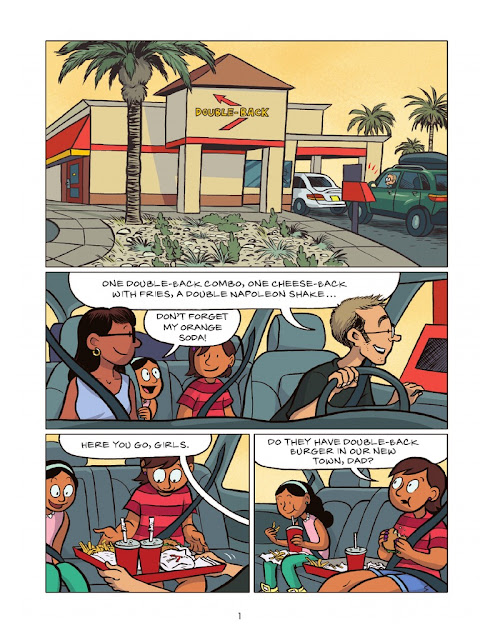
Telgemeier introduces and balances many themes skillfully in Ghosts. There are sibling issues, like Maya's illness and how Cat lovingly protects her but also wants a life of her own, separate from Maya. Then there are family issues that arise as they settle into Bahía de la Luna, which has a large Mexican American population. When the girls learn about Día de los Muertos, the Day of the Dead, which is celebrated with a huge festival and midnight party in Bahía de la Luna, Maya questions her mother about her childhood as a second generation Mexican American. And, with Ghosts, Telgemeier introduces magical realism into her story telling. Carlos Calaveras, neighbor and classmate of Cat's, works as a guide, giving tours of the ghosts of Bahía de la Luna. Cat is suspicious, then furious after she sees that Maya is enthralled with the idea of ghosts and take chances with her health to see one.
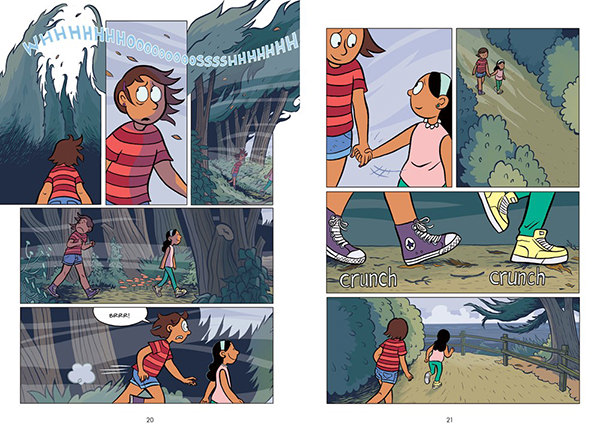
 Cat tries to humor Maya and her excitement over meeting a ghost, but their expedition ultimately puts her in the hospital. Cat spends the rest of the novel coping with her guilt, making new friends, being angry at Carlos and worrying about Maya. Telgemeier ends Ghosts with the marvelous Halloween night, which flows into to the Día de los Muertos celebration where Cat has a change of heart that allows her to make connections with the abuela she never knew, forgive Carlos and make Maya's wish come true.
Cat tries to humor Maya and her excitement over meeting a ghost, but their expedition ultimately puts her in the hospital. Cat spends the rest of the novel coping with her guilt, making new friends, being angry at Carlos and worrying about Maya. Telgemeier ends Ghosts with the marvelous Halloween night, which flows into to the Día de los Muertos celebration where Cat has a change of heart that allows her to make connections with the abuela she never knew, forgive Carlos and make Maya's wish come true.
This is a fantastic trailer that captures the magic of Ghosts!
Raina Telgemeier's books:
Dr Fell and the Playground of Doom, the debut novel by David Neilsen and it is a marvelous mix of silly and supernatural inspired by an illustration of a nursery rhyme created by a legendary children's book illustrator. For more about how Trina Schart Hyman's illustration for the curious nursery rhyme Dr. Fell led Neilsen to write a middle grade novel, be sure to read his guest post, where you can also see the original artwork!
As I read Dr. Fell and the Playground of Doom, I was reminded of more than a few fantastic kid's books. Neilsen's creative naming of his characters and the streets and schools in the the town that Dr. Fell comes to took me back to a longtime favorite, Mrs. Piggle Wiggle by Betty MacDonald. The heroes of the story are ten-year-olds Nancy Pinkblossom and Gail Bloom, and Gail's eight-year-old brother and mortal enemy of Nancy, Jerry Bloom. They live on Hardscrabble Street (near Vexington Avenue and Von Burden Lane) and attend McKinley Grant Fillmore Elementary School, where the heads of the PTA are Candice Gloomfellow and Martha Doomburg. Classmates include Sharon Rottingsly, Jud Fetidsky, Abner Fallowmold, Horace Macabrador, Ethel Pusster and Lars Ouzewuld. All these kids and many more are the gleeful guests of the most amazing playground EVER built by the curious new neighbor who has moved into to the dilapidated house at the end of Hardscrabble Street. The more kids play on the Dr. Fell's playground, the more they want to play on it. Soon they are skipping school, strangely, with the support of their parents and educators.
Nancy, Gail and Jerry are having none of this. Having met Dr. Fell, who has an antiquated way of speaking that he always feels compelled to translate, his first day on Hardscrabble Street, they formed their opinions of him quickly and refuse to set foot on even a climbing rope on his playground. The trio, uneasy in their union, watch as more and more children are injured on the playground, returning minutes after a consultation with Dr. Fell in his conveniently nearby home office, completely healed. When an enthusiastic Leonid Hazzardfall takes a tumble from the top of the crow's nest on the play pirate ship in the middle of an impassioned speech urging his fellow playmates to skip school to stay and play and is clearly dead, only to return later, alive and well, the trio really begins to worry.
Dr. Fell's playground calls to mind the Land of Toys from Collodi's The Adventures of Pinocchio, renamed Pleasure Island in the Disney movie. Soon, the trio notices that those boys most frequently injured are starting to need to shave several years ahead of puberty, cementing their conviction that Dr. Fell and his playground need to come to an end. With the help of a crusty old neighbor, Nancy, Gail and Jerry find themselves at the heart of Dr. Fell's mysterious mission, fighting for their lives, or, more specifically, their childhoods...
I don't want to give away too much, but Dr. Fell and the Playground of Doom and the purpose of Dr. Fell also calls to mind Cornelia Funke's marvelous novel, The Thief Lord, and Ray Bradbury's phenomenal Something Wicked This Way Comes. And, while I have (sadly) never read any, Neilsen, a professional actor, story teller and voice actor (you can hear him read the audio of his book HERE) is also well versed in the work of H.P. Lovecraft and is the creator of a one-man show based on his short stories, so I am sure there are influences from his work I am missing. While I can't go so far as to give this book the label Good Fantasy - Harmless Bad Guys, Neilsen weaves a good dose of levity throughout the book, but Dr. Fell and his mission are pretty dark. That said, Neilsen could have taken this plot point and gone in an entirely different, much darker direction and I applaud and thank him for writing a scary-but-not-too-scary book that is also long-but-not-too-long, making it accessible for younger readers.
Source: Review Copy
 Today, something special is happening here. I am participating in a blog tour, but not just any blog tour. Sometimes you read a book and really love it, then you get to the author's notes or the acknowledgements and find something that makes you love it even more. That's exactly what happened to me when I read Dr. Fell and the Playground of Doom by David Neilsen. Neilsen's debut is a marvelous mix of silly, spooky and creepy with a haunting plot point worthy of an episode of The Twilight Zone. Finishing the book, I learned that Neilsen, a professional actor, story teller and voice actor, was inspired by a pen and ink drawing by Trina Schart Hyman, a legendary illustrator who brought many fairy tales to life, winning a Caldecott in 1985 for Saint George and the Dragon, retold by Margaret Hodges. The illustrations of Trina Scahrt Hyman, longtime art director for Cricket magazine, take me back instantly to my childhood. I am thrilled and honored to have the author of a novel inspired by Hyman's work share here, in his own words, how his curiosity was piqued and how his creativity was sparked by this one work of art.
Today, something special is happening here. I am participating in a blog tour, but not just any blog tour. Sometimes you read a book and really love it, then you get to the author's notes or the acknowledgements and find something that makes you love it even more. That's exactly what happened to me when I read Dr. Fell and the Playground of Doom by David Neilsen. Neilsen's debut is a marvelous mix of silly, spooky and creepy with a haunting plot point worthy of an episode of The Twilight Zone. Finishing the book, I learned that Neilsen, a professional actor, story teller and voice actor, was inspired by a pen and ink drawing by Trina Schart Hyman, a legendary illustrator who brought many fairy tales to life, winning a Caldecott in 1985 for Saint George and the Dragon, retold by Margaret Hodges. The illustrations of Trina Scahrt Hyman, longtime art director for Cricket magazine, take me back instantly to my childhood. I am thrilled and honored to have the author of a novel inspired by Hyman's work share here, in his own words, how his curiosity was piqued and how his creativity was sparked by this one work of art.
I hope you’re enjoying the blog tour for David Neilsen’s Dr. Fell and the Playground of Doom! In case you missed yesterday’s post, head over to The Book's the Thing to check it out. The tour continues tomorrow on The Book Monsters. For my review of Neilsen's book, check back here tomorrow!
A Picture is Worth 46,000 Words
Dr. Fell and the Playground of Doom started life as a reaction to an illustration. The picture, done by Children’s Illustrator Trina Schart Hyman, had been hanging on the wall of my in-laws’ home for as long as I’d known them. It was part of a 10-piece collection of drawings done years ago by some of the top children’s illustrators of the time. They were each asked to create a single image based on their favorite fairy tale or fable. Most of the pieces in the collection were based on stories I knew such as Peter, Peter Pumpkin Eater or St. George and the Dragon. The one that caught my eye was labeled simply, “Dr. Fell.” I’d never heard of Dr. Fell, had no idea who he was or what he was about, but the more I looked at the picture, the more intrigued I became.
The image shows a little girl looking up warily at an old man in a suit and top hat. He is smiling down at her in a very creepy way, and on his back, unseen by the girl, is a basket filled with the arms, legs, and heads of little children. This was awesome! How had I never heard of this story before?
I asked my mother-in-law if she knew who Dr. Fell was. She was as stumped as I. So we turned to Google, and discovered Tom Brown’s four-line poem from 1680.
I do not like thee, Doctor Fell,
The reason why -- I cannot tell,
But this I know and know full well,
I do not like thee, Doctor Fell.
My first reaction after reading the poem?
I read the four lines again and again, finding them lovingly creepy but a far cry from arms and legs sticking out a wicker basket.
But then I read a bit more about the history of Doctor Fell. It turns out that those four lines had inspired a number of literary references throughout the ages. Robert Louis Stevenson mentions him in The Strange Case of Doctor Jekyll and Mr. Hyde. Author Thomas Harris had his most famous creation, Dr. Hannibal Lecter, use Dr. Fell as a pseudonym in the book, Hannibal. The original nursery rhyme has been quoted in multiple episodes of the cult-TV show Dark Shadows.
Something about these four lines has sparked a foreboding sense of unease for three and a half centuries. They’d sparked Ms. Hyman to draw a truly-creepy picture. Now they were sparking something in me.
Questions ran through my mind. Who was this guy? What did he want? What was he doing? How was he doing it? Doesn’t anyone notice? As each question popped up, the story began to take shape. What happens when Dr. Fell comes to town? I knew right away that this was a children’s story, so he couldn’t be chopping off the arms and legs of children. There had to be something else he was taking from them, something else he needed them for. When that plot point clicked into place, it was obvious. The playground came next, as the natural vehicle for his monstrosity.
In the drawing, Ms. Hyman has added a few other details; a raven atop a withered tree, the girl having stepped off the path to get out of Dr. Fell’s way, flies buzzing around the basket on his back. All of it combines to give the picture a very lively, magical feel. I took that quality and tried to get it into the story by using heightened language a touch above the normal and expected.
The hardest part for me was creating the heros. There had to be a little girl, because of that image, but one little girl didn’t feel right. One little girl, on her own, was simply not going to be able to defeat the Dr. Fell I was creating. I played with different combinations of boys and girls of different ages for a while, trying to fall upon the right combination. For a while I had only two heros, a brother and sister, but after a couple of false starts, I knew I needed a third, and the trio from the book was finally formed.
All of this came from that single picture. Looking at it now--my mother-in-law gave it to me for Christmas and it hangs on my wall--I still feel that slightly-queasy feeling it gave me when I first noticed it. I owe it, and the late Ms. Hyman, a great debt. Her single image planted a seed in my head that grew to become Dr. Fell and the Playground of Doom.
When Ms. Bixby announces that she is very sick and won't be able to finish out the last weeks of the school year (or even finish the last 20 pages of the class read aloud, The Hobbit) Brand, Steve and Topher decide that they want to give her a proper last day. That's the nutshell summary of John David Anderson's newest novel, Ms. Bixby's Last Day. I knew that this wasn't going to be an easy read, but there was no way I was not going to read (and love) Ms. Bixby's Last Day, tissue box by my side. Anderson's book is a surprise, a delight and a reminder of why I work with kids, how a teacher (or other thoughtful adult) can make a powerful, even if seemingly small at the time, impact on a child's life and how valuable it is to be reminded of this by a work of art. But will kids want to read it?
That's what I wondered as I pored over every page - exactly who would I recommend this book to? One thing that I especially love (among many) about Ms. Bixby's Last Day is the fact that the story is told by three narrators, all sixth grade boys. In this age of (slouching toward) equality, it is a challenge to find a middle grade novel featuring all boy or all girl protagonists. The formula, for fantasy, anyway, is always boys and girls, with boys usually as the main character - think Harry, Ron and Hermione or Percy, Grover and Annabeth. It's a genuine treat to hear the voices of three different boys over the course of 300 pages. Anderson has created three characters, each of whom, to varying degrees, has things going on at home that make Ms. Bixby's unique attention so meaningful. Topher is a gifted artist who misses the way his family was before the birth of his little sister and his mom's return to the workforce. Steve, who once memorized every country (and capital, population and official language) for fun, feels inferior to his older sister, a perfectionist who meets their parents's high standards. Then there is Brand, the quiet, driving force of this trio and the feat they try to pull off while ditching school one Friday. Raised by his dad, Brand's life changed drastically when his father was paralyzed by an accident at work and his will to get back on his feet, metaphorically and literally, disappeared.
Topher, who has classified teachers into six categories, puts Ms. Bixby into the "Good Ones" column - the kind of teachers who you "find yourself actually paying attention in class, even if it's not art class. They're the teachers you actually want to fo back an say hi to the next year. The ones you don't want to disappoint." Ms. Bixby has a talent for recognizing, valuing and nurturing what is special in her students and also for making them think. When the class is deprived of the chance to say goodbye to Ms. Bixby because the treatment for her pancreatic cancer has been pushed up, Brand, Steve and Topher decide to ditch school and take the bus to the hospital to see her. Armed with a special knowledge of how Ms. Bixby would spend her last day on earth (this was a writing prompt she gave her students, one of whom asked her what she would do) the boys carry backpacks, cash, a picnic blanket, a wine glass and more with them as they stop to try to buy the things they need for the special day and meet with obstacles they never saw coming. As Ms. Bixby's Last Day unfolds, each boy narrating part of their odyssey to make it from school to the hospital downtown, Anderson reveals things about their lives and their relationships with Ms. Bixby. He also throws in some tension between the friends along with more than a few hilarious scenes and suspenseful twists as well. Ms. Bixby's Last Day is, as Anderson says in his acknowledgements, a quiet book. There is more reflection than action, but Anderson's story telling style is masterful, with hints to meaningful moments that are revealed powerfully in later pages or chapters. Although a quiet book, Ms. Bixby's Last Day is always moving forward with Steve, Brand and Topher as they make their way to room 428 in St. Mary's Hospital.
So who will I recommend Ms. Bixby's Last Day book to when school starts up again in August? I'm still not sure. But, during the last week of June I was sorting discarded library books to give away and a coworker's daughter, who just finished 7th grade and is quiet and a bit shy, was helping me. I asked her what she likes to read and she responded adventure stories, real life, no fantasy. I pulled a few books off the shelf for her and we sat and read, waiting for people to come to the book give away. A couple of middle school boys zipped by on their bikes and stopped to talk to me, getting a little goofy when they saw my helper. They circled around on their bikes showing off and my helper and I talked about how dumb middle school boys can be. Then I told her about the book I was reading, Ms. Bixby's Last Day, and how it started off with sixth grade boys talking about cooties and being goofy and how they wanted to visit their sick teacher. Later, as we were packing up the leftover books, she surprised me (mostly because of our discussion about dopey boys) by asking if she could borrow my copy of Ms. Bixby's Last Day. I gave her my Advance Readers Copy with the promise that she send a note to work with her mom in August telling me how she liked it.
Source: Review Copy
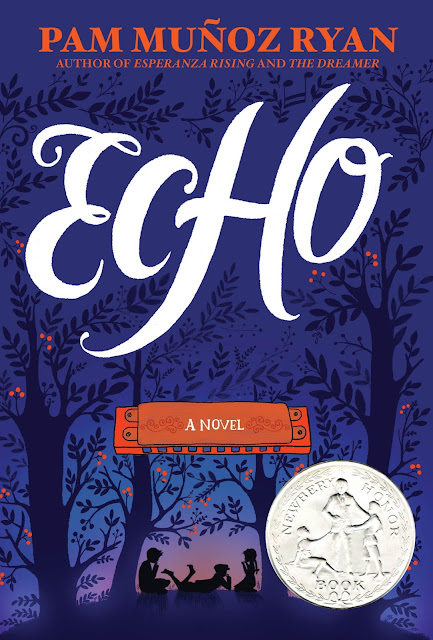
I missed Echo by Pam Muñoz Ryan when it came out in February of 2015. Scholastic is one of the few publishers I don't get review copies from and, working in a library instead of a bookstore now, I an not as up on what's new in the world of kid's books as I once was. I even missed the March, 2015 review of Echo in the New York Times Book Reivew, which I usually scour. Echo crossed my radar in January of this year when it won a Newbery Honor, along with two other superb books, The War that Saved My Life and Roller Girl. While I hate the fact that I didn't read Echo right when it came out, I am so, so glad that I knew absolutely NOTHING about it (save that it won an award) before I began listening/reading it. Having worked with and been an avid reader of children's literature for more than 20 years, I've kind of read it all. There aren't too many plots or characters that surprise me or feel really new and original. Echo surprised me - it's as if A. S. Byatt, an author of novels for adults that are magnificently crafted and often centered around a work of art - wrote a kid's book. If you want to be surprised by a story and you trust me and the librarians who hand out the Newbery awards, stop reading my review after the next sentence and go out and get your hands on a copy of Echo. Actually, I very, very strongly suggest LISTENING to the audio of this book (as well as buying it - you WILL want to own it) because - tiny spoiler alert - music is an integral part of Echo, and you get to hear it in the audio.
Stop reading HERE if you want to be surprised
****************************************
I was definitely surprised when I started listening to Echo and there were music credits before the story began. I was especially surprised when harmonica music kicked in. Like several minor characters in the book, I, too, did not take the harmonica seriously - nor did I notice the drawing (wonderful artwork by Dinara Mirtalipova) of one on the cover and spine of Echo! Echo is a work of historical fiction wrapped in the cloak of a fairy tale that is ultimately a story about the power of music to, "pass along . . . strength and vision and knowledge," and even overcome fear, intolerance and hatred. The story visits three very different children at three different times, starting in 1933 and ending in 1942. The common thread that connects these three children is their passion for music, embodied, at that time, in the harmonicas that they own. Surrounding these stories is the tale of a boy that begins just before the start of the 20th century. From a Gypsy, who presses a mouth harp on him for free, he buys a book titled, The Thirteenth Harmonica of Otto Messenger. The book tells the story of three abandoned princesses with beautiful singing voices. Trapped in the woods under the spell of a witch, they need a messenger to take something out into the world for them, something that will break the spell. Becoming lost in the woods, Otto meets the three princesses from the book. Desperate to know the end of their story, they enchant the harmonica that the Gypsy gave him and he agrees to send it into the world where, if it can "save a soul from Death's dark door," the spell will break and the princesses can return home.
The stories of the three central children in Echo would have been a satisfying book on their own, but linking them with the fairy tale of the three sisters imbues Ryan's novel with a quality of hopefulness and beauty, much like the sound of a well played harmonica. Part one begins in 1933, in Tossingen, Germany, with young Friedrich, a gifted musician. Part two begins in Pennsylvania, 1935. The third and final part begins in 1942, just after Pearl Harbor, in California, a harmonica at the heart of each story. Friedrich has a port wine birthmark on his face and suffers from seizures. Hitler's persecution of physically disabled forces Friedrich and his family to make difficult choices and his story ends without closure, his life in danger. Part two, features orphan brothers, the eldest of whom is a gifted musician, with his only hope for survival hinging on his ability to make it into a renowned harmonica band. Mike and Frankie are adopted by a painfully grieving heiress who needs to produce an heir to keep her fortune, their story also ending in a moment of danger and uncertainty. Finally, Ryan turns to Ivy Maria Lopez, shining a light on xenophobia and racism.
It is Fresno, 1942, and Ivy is the child of migrant farm workers. Her brother, Fernando, has just enlisted and her father has just accepted a job running a farm in Orange County. When they arrive at the farm, the Lopez's discover that it belongs to a Japanese-American family that has been sent to an interment camp. Their oldest child, a son in the Marines, is coming home on leave to sign the running of the property over to Mr. Lopez, if he approves of him. Ivy, and her parents, struggle to understand how the Yamamoto family, with a father who fought in WWI and a son fighting in WWII could be treated this way, while at the same time Ivy experiences racism and segregation when she learns that she is not allowed to attend her neighborhood school, but must go to one that will "Americanize" children like her. Living in California and working with the children of immigrants, many of whom are also the children of migrant workers, this part of the story resonated most with me.
The last two parts of the novel tie together all three stories in a marvelous, deeply satisfying way that had me weeping. Ryan returns to the fairy tale, bookending Echo with the conclusion to the story of the three princesses as well as the story of Otto, now the messenger, and the enchanted harmonica that he must send out into the world and how it gets there. Echo is a big book, but as many reviewers have said, and as was my experience, you will soar through it, drawn along by the beauty if Ryan's writing, the craft of her story and the humanity of her characters.
Source: Purchased Book & Audio Book
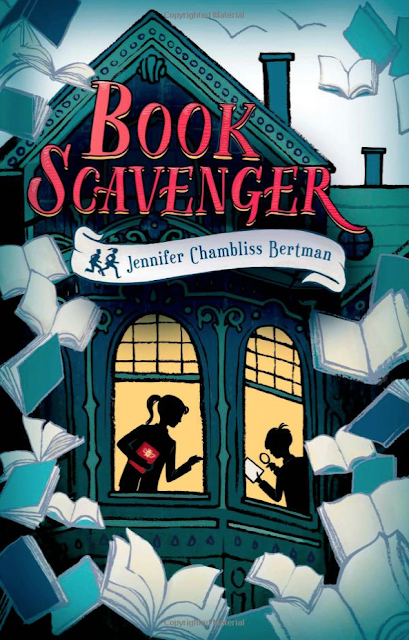
I love books about books and I love mysteries. However, especially in the world of children's literature, it's very challenging to find a well written book of either genre, let alone both together. A solid, believable mystery often means character development is sacrificed. Or, as in two of my all-time favorites, The Westing Game and From the Mixed-Up Files of Mrs. Basil E. Frankweiler, superb character development overshadows the mystery that sets the plot in motion. As an eleven-year-old reader, Ellen Raskin's characters, from Turtle to Theo Theodorakis to Sydelle Pulaski, stuck in my memory well into adulthood. But, as a kid, I was also a little disappointed that the actual clue-gathering game in the book wasn't entirely solvable for readers. With Book Scavenger, Jennifer Chambliss Bertman has written a miraculous middle grade novel that almost perfectly balances character development with a solid, believable, puzzle filled mystery that readers can unravel themselves. Even better, the mystery revolves around books and book lovers! Add to this Sarah Watts's charming illustrations and you have an unforgettable book with character you will want to spend time with again.
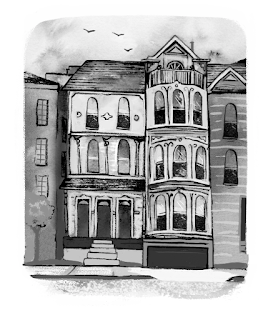 Book Scavenger is Bertman's debut novel and it is masterfully written, especially when considering the multitude of details she weaves into the plot and her characters, making it almost feel like three or four books in one. When she was a baby, Emily Crane's parents decided they wanted to live in all fifty states. Emily's mom even started a blog about their experiences called 50 Homes in 50 States. As Book Scavenger begins, the Cranes are moving from New Mexico to San Francisco. Emily is growing tired of not being able to set down roots, and Bertman writes poignantly of her growing frustration with this. However, as a dedicated Book Scavenger, she is thrilled to be moving to the home base of publisher, puzzle master, book lover and eccentric, Garrison Griswold. Like Chris Gabenstein's game creator, Mr. Lemoncello, Griswold is a bit of a Willy Wonka-type. However, Griswold's puzzles revolve around books, and his Book Scavenger website allows participants to hide books (you can even purchase clever book disguises from the website) and leave clues for other Book Scavengers to find it. Bertman's rules for book scavenging open Book Scavenger and are very well thought out and doable. So doable, in fact, that she created a low-key version of Griswold's game that you can play here!
Book Scavenger is Bertman's debut novel and it is masterfully written, especially when considering the multitude of details she weaves into the plot and her characters, making it almost feel like three or four books in one. When she was a baby, Emily Crane's parents decided they wanted to live in all fifty states. Emily's mom even started a blog about their experiences called 50 Homes in 50 States. As Book Scavenger begins, the Cranes are moving from New Mexico to San Francisco. Emily is growing tired of not being able to set down roots, and Bertman writes poignantly of her growing frustration with this. However, as a dedicated Book Scavenger, she is thrilled to be moving to the home base of publisher, puzzle master, book lover and eccentric, Garrison Griswold. Like Chris Gabenstein's game creator, Mr. Lemoncello, Griswold is a bit of a Willy Wonka-type. However, Griswold's puzzles revolve around books, and his Book Scavenger website allows participants to hide books (you can even purchase clever book disguises from the website) and leave clues for other Book Scavengers to find it. Bertman's rules for book scavenging open Book Scavenger and are very well thought out and doable. So doable, in fact, that she created a low-key version of Griswold's game that you can play here!
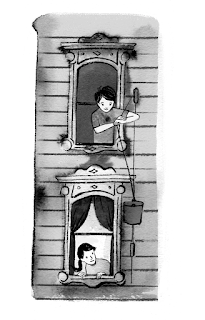 Emily has the good luck to meet James, upstairs neighbor and grandson of the owner of the building her family moves into. James is a puzzler, although not a Book Scavenger, and he helps Emily decode an especially difficult clue to a book. Emily, James and Matthew head down to the Ferry Building to look for the book and, on their way home discover an even better hidden book. Just the day before, as he was on his way to announce his newest literary-puzzle-scavenge-game, Griswold was attacked and left unconscious. Emily finds the book that was to start the games, an edition of Edgar Allan Poe's, "The Gold-Bug." In the short story, the protagonist cracks a cryptogram that he hopes will lead him to a buried treasure and Griswold has a similar mystery planned for his followers. Emily quickly realizes that the book she found is part of Griswold's new game and that she is being followed, possibly by Griswold's attackers. With James's help, along with Hollister, a dreadlocked bookstore owner who was best friends and partners with Griswold decades ago, they rush to uncover the mystery and find the treasure - if there is one.
Emily has the good luck to meet James, upstairs neighbor and grandson of the owner of the building her family moves into. James is a puzzler, although not a Book Scavenger, and he helps Emily decode an especially difficult clue to a book. Emily, James and Matthew head down to the Ferry Building to look for the book and, on their way home discover an even better hidden book. Just the day before, as he was on his way to announce his newest literary-puzzle-scavenge-game, Griswold was attacked and left unconscious. Emily finds the book that was to start the games, an edition of Edgar Allan Poe's, "The Gold-Bug." In the short story, the protagonist cracks a cryptogram that he hopes will lead him to a buried treasure and Griswold has a similar mystery planned for his followers. Emily quickly realizes that the book she found is part of Griswold's new game and that she is being followed, possibly by Griswold's attackers. With James's help, along with Hollister, a dreadlocked bookstore owner who was best friends and partners with Griswold decades ago, they rush to uncover the mystery and find the treasure - if there is one.
 Bertman does a magnificent job weaving literary references and puzzles of all kinds into Book Scavenger. Set in San Francisco, the Beat writers, from Kerouac to Ginsberg to Ferlinghetti and his landmark City Lights Bookstore are part of the plot. In addition to the challenge of Griswold's new game, Emily struggles to be a good friend to James, mend her relationship with Matthew and ultimately tell her parents that she does not want to be part of their adventure anymore. Matthew is also a well developed character and his devotion to a band called Flush along with his homemade videos using their music, dovetail seamlessly with the mystery and adventure of Book Scavenger. As with all children's books, the bad guys can't be that bad. The villain in Book Scavenger is a sour sort with a sense of entitlement that drives him to drastic measures, but it is really the goons he hires to do his dirty work who commit the crime of shooting Griswold in the subway at the start of the novel.
Bertman does a magnificent job weaving literary references and puzzles of all kinds into Book Scavenger. Set in San Francisco, the Beat writers, from Kerouac to Ginsberg to Ferlinghetti and his landmark City Lights Bookstore are part of the plot. In addition to the challenge of Griswold's new game, Emily struggles to be a good friend to James, mend her relationship with Matthew and ultimately tell her parents that she does not want to be part of their adventure anymore. Matthew is also a well developed character and his devotion to a band called Flush along with his homemade videos using their music, dovetail seamlessly with the mystery and adventure of Book Scavenger. As with all children's books, the bad guys can't be that bad. The villain in Book Scavenger is a sour sort with a sense of entitlement that drives him to drastic measures, but it is really the goons he hires to do his dirty work who commit the crime of shooting Griswold in the subway at the start of the novel.


Finally, Bertman works in references to Masquerade, the picture book written and illustrated by Kit Williams that was published in 1979 and promised clues to a buried treasure. I remember seeing Masquerade in a bookstore shortly after it was published and begin intrigued by the beautiful illustrations, not realizing that there was a treasure - and controversy - connected to this book. Masquerade, along with a family connection to Edgar Allan Poe, all of which are explained in Bertman's notes at the end of the book, inspire Griswold in his literary game creations.
Coming January, 2017!!!
Source: Purchased Book and Audio Book
for more reviews of books that are mysteries with puzzles, like these:
As a two time Newbery Medal winner, Newbery Honor winner and National Ambassador for Young People's Literature, a new book from Kate Di Camillo is a big deal, especially one like Raymie Nightingale. DiCamillo's books span a range of reading levels, from easy readers like Bink & Gollie and Mercy Watson to more nuanced novels like The Tale of Despereaux and Because of Winn Dixie. Whatever the reading level or subject of a book, you can always count on Di Camillo's distinctive eccentricity, sort of a Southern Gothic for kids.
Raymie Nightingale is set in 1975 in a small town in Central Florida. Di Camillo creates a world you can almost feel and smell, where the searing summer sun heats the sidewalks so that they are still warm at five in the morning and a blinding glare comes off Lake Clara, named after a woman who may or may not have drowned herself there while waiting for her husband to return from the Civil War. A third person narrator lets us see into the mind and heart of ten year old Raymie Clark, who has just suffered a great tragedy. Two days before the story begins, her father "had run away from home with a woman who was a dental hygienist," leaving Raymie with a sharp pain shooting through her heart every time she considers it. I think my favorite thing about Raymie Nightingale and the character of Raymie herself is the way that she experiences and describes her emotions. As a child, I know I had no idea that the physical sensations I felt in my body might be connected to emotions I was experiencing, and have Raymie as a guide would have been invaluable. Di Camillo quickly switches from locating feelings in Raymie's heart to finding them in her soul. Sometimes she feels like her soul is shriveling, other times, it feels like it is "filling up - becoming larger, brighter, more certain," almost like a tent.
Raymie has a plan to get her father to notice her and return home. She is going to win the Little Miss Central Florida Tire competition and get her picture in the newspaper. But first, upon the advice of his secretary, she has to learn to twirl a baton from local champion, Miss Ida Nee. Beverly Tapinksi and Louisiana Elefante are also taking lessons from Miss Ida Nee in order to ensure a win in the Little Miss Florida Tire competition. Beverly wants to sabotage the contest for reasons of her own and Louisiana wants the $1,975 prize money so that she and her grandmother can stop stealing canned food from the Tag and Bag. While never learning to twirl, the three girls do find themselves forming a quick and close bond as they are thrown into, or walk into, a series of curious, quasi-dangerous events. From an attempt to do a good deed at a nursing home that ends with a hair raising fright, to jimmying a lock and stealing a baton from a room covered, floor, walls and ceiling, in green shag carpet, to a midnight rescue and a shopping cart ride that ends in a pond that once was a sinkhole, the girls each have the chance to come to the rescue in unexpected ways.
As an adult reading Raymie Nightingale, the true gift of this novel and Di Camillo's writing is her ability to concisely and gently convey that period of childhood when you start to take notice of the ways of the adults around you and also feel like you might have some amount of control over your own life and your ability to steer the ship. Like most kids, Raymie might be able to see the adult world but she doesn't really understand how it works or how to work with it. And, while her attempts might fall short or flat out fail, Raymie has Beverly and Louisiana by her side and they will always be the Three Rancheros.
Souce: Review Copy
Human Body Theater: A Non-Fiction Revue, the new graphic novel by Maris Wicks is a fantastic way to learn a vast amount of information in a very fun format. Wicks is the illustrator of one of my favorite non-fiction graphic novels, Primates: The Fearless Science of Jane Goodall, Dian Fossey and Birute Galdikas, written by Jim Ottaviani. In eleven acts, a skeleton takes readers through the main systems of the body, beginning with the skeletal system and working up at the excretory system just before intermission. After that, five more systems are visited, from the endocrine system to the reproductive, immune and nervous systems, ending with the five senses. And, as you can see, Wicks's illustrations are fantastic. Crisp and clear, with a bright color palette and images outlined in black, Human Body Theater is a treat to look at that you will find yourself poring over. 
After a quick introduction to the hardworking stage hands, the cells, bones then muscles are explored. I'll be honest, I have vague memories of learning about the human body in my high school biology class and it was largely uninteresting and forgettable. However, Wicks's illustrations and presentation are so inviting that I genuinely enjoyed my trip through the human body! I guess giving faces and smiles to things like a cytoplasm, a Gogli body and atoms is just entertaining enough to keep my attention. To illustrate how the heart and the lungs work together to supply the body with oxygen, Wicks brings two, pink oxygen molecules in tutus on stage to dance readers through the process.

The Blood Bus takes readers through the cardiovascular system and a peanut butter and banana sandwich explains carbohydrates then, with a note of glee exclaims, "But what's really exciting is that I'm going to get eaten!" The scene ends with the natural conclusion. There is a splash in the toilet on stage and the skeleton thanking the sandwich for an "informative performance." There are also brief forays into heartburn, constipation and the fact that stomach aches, constipation, vomiting and diarrhea can be caused by the brain and the benefits of relaxing and removing stress for the whole body.

 Human Body Theater very tactfully covers the reproductive system, starting with the endocrine system and hormones. Wicks very tactfully uses descriptions rather than depictions for this scene. While there is a sperm and an egg with faces that talk, along with anatomical images of the sex organs, many readers might not even realize what they are looking at. Menstruation and erections are covered along with other changes that puberty brings, like body odor, pimples, hair growth, voice changing and breast development. The scene ends with pregnancy, birth and infancy. After a romp through the five senses, the skeleton ends the show by putting on some skin, then quickly stepping behind the curtain for some clothes.
Human Body Theater very tactfully covers the reproductive system, starting with the endocrine system and hormones. Wicks very tactfully uses descriptions rather than depictions for this scene. While there is a sperm and an egg with faces that talk, along with anatomical images of the sex organs, many readers might not even realize what they are looking at. Menstruation and erections are covered along with other changes that puberty brings, like body odor, pimples, hair growth, voice changing and breast development. The scene ends with pregnancy, birth and infancy. After a romp through the five senses, the skeleton ends the show by putting on some skin, then quickly stepping behind the curtain for some clothes.
In an excellent move, Wicks includes a glossary, with the ASL sign for each letter starting off each section, then a bibliography and suggested reading section!
Besides being a first rate author and illustrator and graphic novelist, Maris Wicks has a background in oceanography and education, having worked at the New England Aquarium where she taught children about marine science. This month she can be found on the R/V Atlantis doing research for the Woods Hole Oceanographic Institution. This all makes perfect sense because Wicks's next graphic novel, coming later this month, can be seen below!
Source: Review Copy
I love it when I find a graphic novel that is as enjoyable as any by Raina Telgemeier, and Awkward by Svetlana Chmakova is right up there, along with Newbery Honor winner Roller Girl by Victoria Jamieson. Chmakova's illustration style is reminiscent of Japanese manga - her characters have exaggerated expressions that add to the humor and emotions of the story. And her color palette is pale yellows, pinks and blues with occasional pops of darker colors. The plot of Awkward shows good kids making bad choices and working hard to making things right. Above all else, the kids in Awkward are creators - they make, they build, they draw. Chmakova ends her wonderful story with these words, "Cardinal Rule #3 for Surviving School: Build. Build things. Build Friendships. Build yourself. Bit by little bit. It may feel like you're not adding that much . . . but in the end, it will add up to a lot."
But, before we get to those wise words, we need to go back about 200 pages to the beginning. Penelope Torres, known as Peppi, is new at Berrybrook Middle School. Not only does she suffer the humiliation of of tripping in the busy hallway and spilling all her books on her first day, overloaded and embarrassed, she makes a bad choice. Peppi's Cardinal Rule #1 for surviving school, "Don't get noticed by the mean kids."
When a friendly student stops to help Peppi, the mean kids start making fun of both of them and Peppi does the unthinkable. Without thinking, she pushes the nice kid and runs off, then regrets it almost every minute of every day afterward.
Struggling in science class, but happily making new friends in art class, Peppi gets caught up in school club drama. The art club and the science club have to compete for the last table at the Club Fair. In the middle of all this, Peppi finds herself trying to apologize to Jamie, the nice kid she pushed, who just happens to be in the Science Club.
Chmakova layers lots of great details and characters into Awkward. There is Maribella, the president of the Art Club, who listens to Peppi's ideas but makes a few bad choices of her own that leave Peppi in a tough spot. There is a great field trip scene at the Natural History Museum and a thread that involves geocaching. And, of course, there are the art and science projects and the teachers who lead these clubs - the harried, paper wasting art teacher, Mr. Ramirez and the super-cool science teacher, Miss Tobins. Best of all, Awkward is not a quick read, which means that you have more time to savor it before starting it all over again.
Source: Purchased Copy
In the summer of 2013 I enthusiastically reviewed Escape from Mr. Lemoncello's Library by Chris Grabenstein. While there wasn't much of a set up for a sequel, I was equally excited to read Grabenstein's next book, again with superb cover art by Gilbert Ford, The Island of Dr. Libirs. Set on an island, and not in a library, The Island of Dr. Libris, is rich with literature, mystery and adventure. So, I am especially happy to be reading and reviewing Mr. Lemoncello's Library Olympics - especially since now I am a librarian and I can feel a sense of pride and connection with the outpouring of library and librarian love in Grabenstein's newest book.
I have to say that I think that Mr. Lemoncello's Library Olympics is a stronger, more meaningful book that Escape from Mr. Lemoncello's Library, reminding me in many ways of a childhood favorite I continue to love as an adult, Ellen Raskin's, The Westing Game. There is a game, a mystery, and benevolent benefactor secretly hoping to bestow a fortune on a worthy youngster. Mr. Lemoncello's Library Olympics has everything that Escape from Mr. Lemoncello's Library has - puzzles, problems, competitions, cheating, action, adventure, excitement, and references to scads of great kid's - and more. At the start of this new book, kids from all over America are writing to Mr. Lemoncello asking for the chance to compete in a library competition just like Kyle and his crew, winners from the first book and minor celebrities, having starred in commercials for Mr. Lemoncello's newest games. Mr. Lemoncello agrees and conceives of the Library Olympics or the duodecimalthon - a decathlon, only with twelve games instead of ten. And, naturally, the Library Olympics are broadcast on "many PBS stations, the Book Network cable channel and NPR."
Children from all over the country compete for a spot on one of the teams representing seven regions who will compete at the library in Alexandriaville, Ohio. In addition to a solid knowledge of the Dewey Decimal System, shelving, kid's books, research and, of course, puzzles like pictograms and more. Grabenstein weaves in a plot thread of censorship, banned books and ideas about what makes a library a library, which I especially appreciated. In this digital age, libraries have to change from dusty book warehouses in order to stay relevant. Things like makerspaces, and creatorspaces are things that I research regularly and work to incorporate into my library, which almost always functions at a level of cheerful, low grade chaos. There is no shushing going on in my library. Grabenstein incorporates characters, both children and adults, who are shocked by the library that Mr. Lemoncello has created. Upon winning a spot on her regional team, Marjory Muldauer, a gangly seventh grader from Michigan with a passion for organizing, says of Mr. Lemoncello, "I don't think he loves libraries qua libraries . . . He thinks they need to be tricked out with gadgets and gizmos and holographic displays. That library in Ohio reminds me of Disneyland with a few books. I think Mr. Lemoncello is seriously immature. He probably still believes in three-nine-eight-point-two." 398.2 is the call number for fairy tales, folk tales and myths, my second favorite section after 745.1, graphic novels.
There is also Charles Chilington, expelled from the original games for cheating, and his mother who thinks that the library, the public library, needs a board of directors, one without the presence of Luigi Lemoncello. Add to this Andrew Peckleman, the boy that Charles bullied and pressured in the last games, ruining his love of libraries. Andrew is working at the Blue Jay Extended Stay Lodge, now known as Olympia Village for the duration of the competition. The contestants, who are competing to win a full college scholarship, are shuttled from Olympia Village to the library each day in a bookmobile. Finally, an Arthur Slugworth (the pseudo bad guy in Charlie and the Chocolate Factory who tries to woo away Golden Ticket winners to the dark side) type character rounds out the plot and ties up some threads - including stollen books and more cheating - in a very satisfying way. Grabenstein gets in some great quotes, such as Neil Gaiman's, "Google can bring you back one hundred thousand answers. A librarian an bring you back the right one." And, in a poke at the Patriot Act, a great plot twist where a culprit could be nabbed IF Mr. Lemoncello didn't "protect each library user's right to privacy and confidentiality with respect to information sought and received and resources consulted, borrowed, acquired or transmitted."
You don't have to have read Escape From Mr. Lemoncello's Library to enjoy Mr. Lemoncello's Library Olympics, but I hope you will read both. This is definitely a book that I will never forget and one that I plan to read a second time, something I rarely do. If you loved Grabenstein's books and are looking for more of the same, check out this label for book reviews on my blog: Mysteries with Puzzles
Source: Review Copy
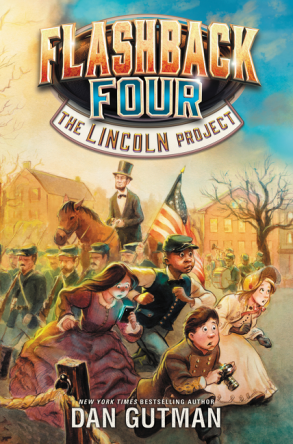
Although his is a prolific and much loved author, I had not read any of Dan Gutman's books until my son and I started reading The Genius Files together in 2014. We were both immediately hooked by Gutman's sense of humor and I was especially impressed with the amount of fascinating factual information he packed into his books. Taking a cross country trip from California to Washington D.C. in a motorhome with their parents, twins Coke and Pepsi (of course there is a funny, interesting story behind their names) see some of the stranger (real) sites in the U.S., like the Pez Museum, the world's largest ball of twin and the House on the Rock in Wisconsin. With his new series, Flashback Four, Gutman brings the same sense of humor and way with the fact to this story of four twelve-year-olds from Boston who get the chance to travel through time, with great cover art by Scott Brundage. For years I have wondered why no one has taken the formula of the Magic Tree House books and applied it to middle grade novels, which is what I think Gutman is brilliantly doing here.
Gutman begins Flashback Four: The Lincoln Project with and introduction that gives readers a peek at the climax of the book. It's Thursday, November 19, 1863 and Abraham Lincoln is delivering the Gettysburg Address. In the crowd, a boy holds a small device in his hand, "silvery and metallic, it's small enough to fit in one hand, but powerful enough to change every history book ever written." Chapter one introduces the four main characters, David, Luke, Isabel and Julia, each of whom receive a mysterious yellow envelope that contains an invitation to a meeting with the CEO of the Pasture Company and four crisp five dollar bills. Assembled in the office of Chris Zandergoth, the four are a bit surprised when the CEO turns out to be a woman. Gutman writes, "Although we've come a long way in the last fifty years, here in the twenty-first century, most of us still assume that any rich, powerful person is a man." And the assumption is an accurate one: as of this writing, there are only 23 women who are CEOs of Fortune 500 companies, making up a whopping 4.6%. But, that's pretty heavy for a kid's book. And hopefully Gutman and his very cool character Chris Zandergoth, a prodigy who dropped out of Stanford to start Findamate, helping people find their "love match" by hacking into the computers of the NSA, will inspire young readers to break through the glass ceiling.
Julia, Isabel, David and Luke learn all this about Zandergoth when they Google her while she is, strategically, in the bathroom. Returning, she tells the kids, "I figured that letting you kids do a little research would be a lot easier than telling you my own boring life story." She goes on to tell them that she has chosen them very carefully using her powerful software algorithms. This revelation is followed by my favorite scene in the book during which Gutman brilliantly uses his characters to directly address a somewhat cynical observation I had made. David somewhat sneeringly responds, "Two boys. Two girls. I guess you picked me because you needed a black kid?" Isabel chimes in with, "I suppose I'm the token Hispanic?" Luke caps it by saying, "What, no Asian? How do you expect to win Multicultural Humanitarian of the Year?" Miss Z laughs it off, telling the four that she matched them up for their, "compatibility, not your ethnicity." Diversity in kid's books is a front burner issue these days, especially with Matt de la Peña becoming the first Latino to win the Newbery Medal for his picture book Last Stop on Market Street. de la Peña has said that this book is representative of his new approach to featuring diverse characters in his books, where he strives to continue to feature diverse characters but "now I try to place them in stories that have nothing to do with diversity, not overtly anyway." Not only is that what Gutman is doing here, but he is also letting us know that he is doing it in a very funny way that I think is great.
Miss Z., who has a passion for photography, a love of history and a great collection of photos from important moments in time, has enlisted the four kids to travel back in time and take pictures of monumental moments using a very smart smartboard, known as the Board, that she and a team worked years to perfect. The first assignment for the Flasback Four, as they name themselves: travel back to the Gettysburg Address and take a picture of Lincoln as he delivers it. This is not as easy as it sounds since the speech lasted less than three minutes. And, understandably, David has some serious concerns as an African American, despite the fact that he will be traveling to the Free North, saying, "I saw that movie Twelve Years a Slave. That guy was in New York when he got kidnapped. I'm not about to get myself sold into slavery just to take a picture." Miss Z. reassures him and prepares the kids for their trip, giving them a list of expression from the era and, of course, clothes. She also gives them a Text Through Time device that looks a lot like a smartphone and allows the kids to communicate with Miss Z and a snazzy new Nikon camera. Everything should go swimmingly.
But it doesn't. Miss Z. makes a typo and sends the Flashback Four back in time a day early. Instead of spending a couple of hours in 1863 they now have to spend twenty-four. Then there is the problem of Julia, who seems to be a bit of a kleptomaniac who is obsessed with making money, even though her family is wealthy. She manages to sneak into the home of David Wills, the man responsible for creating a cemetery honoring Union soldiers who died in the Battle of Gettysburg, and the place where Lincoln spent the night before the address. Luke, David and Isabel stop her from stealing Lincoln's draft of the speech, but not before they encounter Tad Lincoln and his toy gun.
I learned quite a bit reading Flashback Four: The Lincoln Project, and not just boring stuff like dates and places. At one point, the kids end up in jail next to the town drunk who just happened to be one of the civilians who tried to bury the dead after the battle. He tells the kids of the gruesome facts of the battle, the amputations, and worse. Gutman includes a "Facts & Fictions" at the end of the book where he sheds more light on interesting aspects of the book and fesses up about some liberties he took. Does the Flashback Four get the picture? Do they make it back to Boston safely? And where are they headed next? I can't wait to find out!
Source: Review Copy
Mabel Jones and the Forbidden City is the second book in Will Mabbitt and by Ross Collins's superb new series and, if possible, it's even better than the first, The Unlikely Adventures of Mabel Jones. In the first book, Mabbitt introduced our hero who is conscripted into the life of a pirate because she was caught doing THE DEED (picking her nose and eating it) and allowed to stay (despite being a girl) because she can read. The Unlikely Adventures of Mabel Jones is a panoramic sweeping story packed with richly detailed and very imaginative characters and places. With Mabel Jones and the Forbidden City, the story becomes more personal and urgent for Mabel.
 When we see Mabel again, she is in her room, scratching her armpit and staring at a "funny-looking thing, all fat and helpless. Like a beetle grub. Kind of slimy, but kind of cute, too." It's Mabel's baby sister Maggie, and mere minutes after this sweet scene of sibling love, Maggie is taken out of her room by a nasty tasting, powerful creeping vine. Mabel grabs on to the last bit of the disappearing vine and finds herself in a wardrobe in another time and place - the Noo World, specifically, the City of Dreams, a sort of post-apocalyptic, dangerous civilization built upon the remains of New York City.
When we see Mabel again, she is in her room, scratching her armpit and staring at a "funny-looking thing, all fat and helpless. Like a beetle grub. Kind of slimy, but kind of cute, too." It's Mabel's baby sister Maggie, and mere minutes after this sweet scene of sibling love, Maggie is taken out of her room by a nasty tasting, powerful creeping vine. Mabel grabs on to the last bit of the disappearing vine and finds herself in a wardrobe in another time and place - the Noo World, specifically, the City of Dreams, a sort of post-apocalyptic, dangerous civilization built upon the remains of New York City.

Mabel in in America - and once again having an adventure in her pajamas, and this time bunny slippers as well. Once she gets her bearings, she heads off to the dwelling of Mr. Habib, a beak-collecting fortune teller who might be able to tell her where to find Maggie. Mable almost gets her nose snipped off to add to the collection, but she does get a lead and soon she in afloat again. This time, she has secured a position on a little paddle steamer, the Brown Trout, upon which she will be cruising down the Great Murky River to the Forbidden City, rumored to be under the thrall of a wicked sorceress. This expedition is being headed (and funded) by Professor Carruthers Badger-Badger, Phd and Timothy Speke, an otter who enjoys sketching and loves his damson jam. They are journeying to the Forbidden City to find a diamond the size of a gorilla's fist, seen in a faded advertisement from a magazine.
Mabel Jones and the Forbidden City finds the return of old friends, some of whom are now enemies, a flock of zombified egrets under the sway of the Witch Queen, a sunken high school full of skeleton students and the Scuttling Death, rival adventurer Sir Gideon Scapegrace and an epic climactic scene that will have you on the very edge of your seat as Mable prepares to make a huge sacrifice.
Not to fear, there will be another book in the Mabel Jones series! Without giving too much away, Mabel Jones and the Forbidden City ends with her staring out over the vast wasteland that was once New York City, picking her nose and wondering what happened to all the "hoomans."
The Unlikely Adventures of Mabel Jones
A few of the many books by Ross Collins!
Source: Review Copy
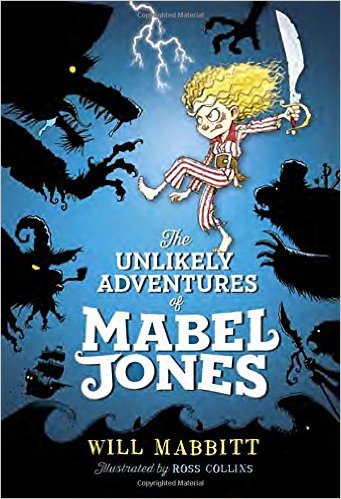
I have had The Unlikely Adventures of Mabel Jones by Will Mabbitt with illustrations by Ross Collins on my To Be Read shelf for a year now. The impending publication of the second book in this series, Mabel Jones and the Forbidden City, combined with the possible chance to have author Will Mabbitt visit here lit a fire under me and got me reading. Once I started, I couldn't stop! The Unlikely Adventures of Mabel Jones is every bit as absurd and adventurous as the title, illustrations, blurbs and reviews promise. As one reviewer touted, Mabbitt's book is a bit like Monty Python meets Jack Sparrow. While this is definitely accurate, for me Mabel Jones and her crew call to mind the brilliant, equally creative but darker work of two of my favorites, Chris Riddell and Paul Stewart and their series, The Edge Chronicles. Mabbitt's story and Collins's illustrations are perfectly paired and the design of the book is fantastic. There is a great mix of fonts and font sizes and one fantastic spread where, in the midst of a massive storm at sea, the text slips and slides off the page! Mabel Jones's richly illustrated, patently hilarious adventures are an absolute MUST READ for everyone.
 When an omniscient (and very talkative) third person narrator first introduces us to Mabel Jones, she is about to be bagged by the kidnapper Omynus Hussh. Hussh, a slow loris who was kidnapped by Captain Idryss Ebenezer Split at birth, is a "dastardly breed: quiet as a peanut and sneaky as a woodlouse in a jar of raisins." Even if you have no idea what a woodlouse in a jar full of raisins is, it SOUNDS funny! And the names of the all animal crew! Mabbitt is a master of names. Besides Hussh and Split, there is Split's boat, the Feroshus Maggot, a pipe smoking goat pirate named Pelf, a mole who is the "best shortsighted lookout ever to have mistaken a pirate ship for an optician's shop," McMasters, and Mr. Clunes, an orangutan who is the strong and silent type. Finally, there is Old Sawbones, a crocodile who has a certificate in Advanced Nautical Surgery from the Butcher's Guild.
When an omniscient (and very talkative) third person narrator first introduces us to Mabel Jones, she is about to be bagged by the kidnapper Omynus Hussh. Hussh, a slow loris who was kidnapped by Captain Idryss Ebenezer Split at birth, is a "dastardly breed: quiet as a peanut and sneaky as a woodlouse in a jar of raisins." Even if you have no idea what a woodlouse in a jar full of raisins is, it SOUNDS funny! And the names of the all animal crew! Mabbitt is a master of names. Besides Hussh and Split, there is Split's boat, the Feroshus Maggot, a pipe smoking goat pirate named Pelf, a mole who is the "best shortsighted lookout ever to have mistaken a pirate ship for an optician's shop," McMasters, and Mr. Clunes, an orangutan who is the strong and silent type. Finally, there is Old Sawbones, a crocodile who has a certificate in Advanced Nautical Surgery from the Butcher's Guild.
And how does Omynus Hussh know that Mabel is good for bagging? She was observed doing THE DEED - the deed that shows she is a pirate in the making. And what is this deed? Well, Mabel was observed picking her nose and eating her booger. And thus she was bagged. But not without some distress. Mabel got a good chomp on Hussh's paw, causing it to go septic, necessitating an amputation by Old Sawbones. Being fresh out of hooks, Sawbones attaches a doorknob to Hussh's stump in what has to be one of the funniest and saddest moments ever in a kid's book. And boy was Hussh sad - so sad he kept is paw with him, cradling it and talking to it like a friend (and a bit like Gollum with his Precious) while also harboring an increasing grudge against Mabel. 
Of course the crew is outraged by the presence of a girl on board and they promptly prepare for her to walk the "greasy pole of certain death." But, this wouldn't be a story without Mabel and she manages to become part of the crew once they learn that she can read! Mabel becomes the key to helping the crew find a buried treasure by reuniting the pieces of the X that marks the spot which just happen to be in the hands of a handful of pirates who were once marooned with Captain Split's father.
The mystery of the missing X is actually pretty mysterious with an edge of creepy, reminding me of Stewart and Riddell's books all the more. There is a Haunted Sea, a sunken city and an army of the dead to contend with before the very dramatic and a tiny bit sad ending that also includes time travel. Happily, I get to dive right in to the next book in the series . . .
Source: Review Copy

By: Tanya,
on 2/1/2016
Blog:
Children's Book Reviews and Then Some
(
Login to Add to MyJacketFlap)
JacketFlap tags:
Historical Fiction,
Award Winner,
ALA Awards,
New in Hardcover,
Reading Level 4,
Real Life Girl Stories,
Historical Fiction: World War II,
HSRL4,
aauthor: Bradley,
Add a tag
The War that Saved My Life by Kimberly Brubaker Bradley came out in January of 2015. In January of 2016 it won the Newbery Honor, the Schneider Family Book Award for the "artistic expression of the disability experience for child and adolescent audiences," and the Odyssey Award for best audio book, with narration by Jayne Entwistle. A couple of months back, Bradley's book came to my attention when I saw it on several end of the year "best of" lists and Newbery prediction lists. After fantasy, historical fiction a very close second favorite genre of mine and without a doubt, The War the Saved My Life is one of the best works of historical fiction I have ever read. In narrator Ada, Bradley has created powerful narrative voice, an unforgettable character and a deeply moving story of survival, both physical and emotional, during WWII England.
Ada is not sure how old she is. She has never been to school, in fact, she has not left the tiny apartment she shares with her mother and younger brother, Jamie, in ages. She is crippled by a club foot and a widowed mother who never wanted to be one. Deeply suspicious, ignorant and filled with anger and hatred, Ada's mother abuses her physically and emotionally, filling her with shame and fear. Ada's only pleasure comes from tending to her little brother Jamie. As he grows older and starts school, his independence leaves her feeling like she should get some of her own. Used to crawling on her hands and knees, Ada slowly, painfully teaches herself to walk. When she learns from Jamie that the children are being evacuated from the city - and that her mother has no intention of letting her go - she sneaks out of the house and joins the evacuees. Upon arriving in Kent, Ada and Jamie, filthy, louse ridden, sick with rickets and impetigo, find themselves unwanted once more. The iron faced Lady Thornton, head of the Women's Voluntary Service, packs the children into her car and takes them to the home of Susan Smith, who refuses to take them, saying she didn't even know there was a war on.
Susan is mourning the loss of her dear friend, Becky, and in her near catatonic state of grief she unthinkingly says that she never wanted children in front of Ada and Jamie. However, Ada catches sight of a pony in the field behind Susan's house and determines to stay. With Susan, Ada faces a new set of challenges, the biggest being trust. Even if she hadn't heard Susan say that she never wanted children, the task of being able to trust Susan would be overwhelming. And this is where Bradley's superior narrative skills shine. With Ada's voice, Bradley conveys the isolation, fear and ignorance that have been her life. So many of the words that Susan says to her mean nothing, from "soup," to "sheets," to "operate," the reader quickly gets a strong sense of disconnect with which Ada moves through the world. This disconnect is expressed most powerfully when Ada is in distress, when her foot hurts or when people are talking about her or touching her. When she was home with her Mam, Ada would retreat, mentally, when the agony of her physical situation - like being locked in a dank cabinet under the sink - was too much to bear. She relies on this relief with Susan, too, imagining herself with Butter, the pony she saw in the field that she teaches herself to ride.
While Ada is an incredible character, Susan Smith is also remarkable. Oxford educated, she herself is familiar with parental disapproval and rejection. Bradley never states it openly, but she weaves enough threads into the story to lead me to believe that Susan and Becky were in love and were ostracized for it. But, Susan exemplifies the motto from the morale boosting poster created during the war, "Keep calm and carry on." In fact, Bradley quotes another poster made by the Ministry of Information to boost morale in The War that Saved My Life. Seeing the poster in town, Susan reads to to Ada, "Your courage, your cheerfulness, your resolution will bring us victory." "That's stupid, it sounds like we're doing all the work," Ada replies, saying it should be, "Our courage, our cheerfulness, our resolution, will bring us victory." This is one of the first moments where Susan sees through Ada's defenses. Susan clothes, feeds and educates Jamie and Ada, persistently, but never forcefully. While she expresses frustration, and both children cringe or hide at times when they think they have truly angered her, she never hits them or raises her voice to them. Instead, she explains herself when called for and hugs them when words will not do. She somehow understands the depths of Ada's emotional wounds and is patient with her when she breaks down, wrapping her tightly in a blanket and hugging - or even sitting on her during their first air raid.
While Ada and Jamie's mother only appears in the first and last few pages of The War that Saved My Life, her presence is a constant throughout. Her abuse of Ada is sometimes horrific, but also sparsely and effectively employed by Bradley. Witnessing this abuse allows the reader to be patient with the often unlikable Ada and also helps the reader understand her decisions, like the choice not to learn how to read or write, and her reactions, like the catastrophic break down she has when, on Christmas Eve, Susan gives her a handmade, green velvet dress, telling her that she is beautiful when she tries it on. Her mother's words, "You ugly piece of rubbish! Filth and trash! No one wants you with that ugly foot!" run through Ada's head and her roaring screams and panic are more understandable. It is even almost understandable that, throughout most of the novel, Ada believes that all the new things she is learning, from walking to horseback riding to reading and writing, will prove her worth to her mother and make her love her. With this possibility always out there, letting herself get attached to Susan is almost impossible. Then, there is always the knowledge of what her mother has thought of her and how she has treated her. Halfway through the novel, Ada says, "I wanted Mam to be like Susan. I didn't really trust Susan not to be like Mam."
But, Ada does get attached and she does grow stronger, physically and emotionally, over the course of this very rich and detailed story. And, while at first it seems like the war is a far off thing, it does come to Kent in a shattering way. After the Battle of Dunkirk, Kent finds itself overwhelmed by injured and dying soldiers, Ada heading into the village to help where she can. There is even a triumphant moment where, following the government dictate to say something if you see something, Ada not only must assert herself, but also let a prejudiced, condescending adult know that her foot is very far away from her brain, something she has heard Susan say, in order to be taken seriously. As life grows more dangerous in Kent and Susan refuses to send Ada and Jamie away, Ada thinks to herself, "It was hard enough to cope with Susan. How would I ever cope without her?"
I was in tears and sobbing for the last half of The War that Saved My Life, especially the final pages. Bradley delivers a very satisfying ending to a deeply satisfying book, one that makes me want to turn around and read it all over again. I am so grateful that this book won a Newbery honor, among other well deserved awards, because it means that it's likely to fall into the hands of children over and over for decades to come. I can't wait to get a copy for my library - I usually donate books I buy for myself to read to my library, but I am keeping this one! - and see what my students think of it!
Source: Purchased
A year ago saw the debut of The Terrible Two by Mac Barnett, Jory John and illustrator Kevin Cornell. A standout for being laugh out loud funny (not as common a trait in kid's books as you might expect), The Terrible Two began the story of Miles, new kid in Yawnee Valley and master prankster, and his nemesis, Niles, the rule-following, goody-two-shoes, sash-wearing School Helper. The Terrible Two took a terrific turn when (SPOILER ALERT) it turned out that the angelic Niles was actually the secret prankster challenging Miles's status. The two teamed up, repeated the prankster's oath and shared a secret handshake before going on to pull off the greatest prank at Yawnee Valley Science and Letters Academy ever against their favorite target, Principal Barkin. Niles, Miles, Principal Barry Barkin, and his entitled son Josh are back in The Terrible Two Get Worse, along with Principal Barkin's father, retired Principal Bertrand Barkin. 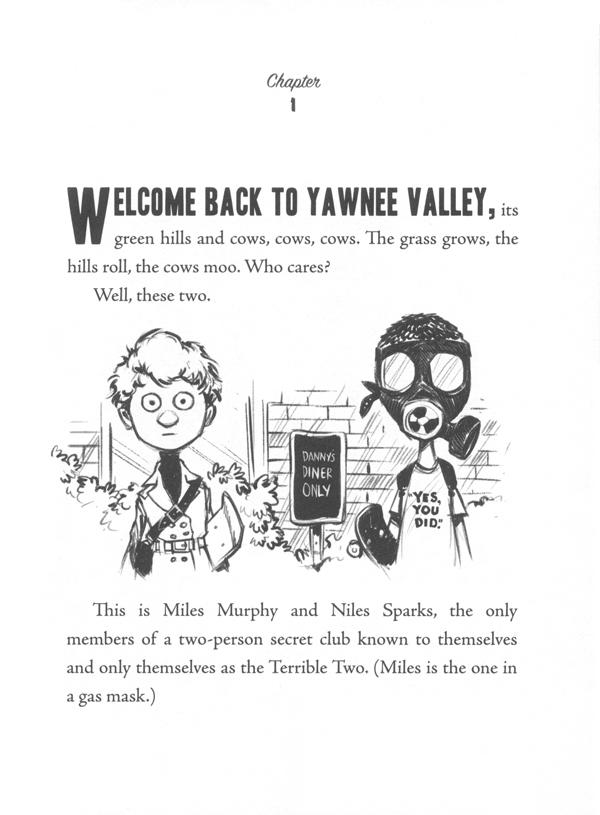
The new school year seems to be off to a great start for the Terrible Two, who begin by smearing Limburger cheese all over the undercarriage of Principal Barkin's yellow hatchback as he enjoys Sunday brunch with Josh at Danny's Diner. The pranks continue into the school year until Bertrand Barkin decides to put an end to it by forcing his son out of his job and returning to his old job. Even worse, Bertrand Barkin, who sets up a giant sign to show how many prank-free school days have passed, has the personal motto, "It is only a prank if we react." As Principal Barkin the elder continues to refuse to react to Niles and Miles's pranks, the Terrible Two begin to get desperate. Niles even has an existential crisis that causes him to vomit and retreat to his room for several days. But, the Terrible Two are not down for long, and they come up with a crazy plan to take down Bertrand Barkin that includes expanding the Terrible Two to Three...

As before, The Terrible Two Get Worse is hilarious and hard to put down. What I love about Barnett and John's series is that the humor is smart. What other kid's book can throw out concepts like Chekov's Gun and Occam's Razor? And, happily, the presence of two items that seem to be Chekov's guns (a spool of thread and the suspenders-belt combo worn by Bertrand Barkin) are explained by the end of the book. And, in a wry and kind of eerie scene, Ms. Shandy, the social studies teacher, unveils a lesson during which the class will be living in a totalitarian state for two days, divided into groups that will create propaganda and samizdat in the style of Alexei Khvostenko. Of course Miles, Niles and their pal Holly Rash, school body president and a character I hope we see A LOT more of in the next book, decide to create samizdat, that is, until Principal Bertrand Barkin shuts the project down. Also, Cornell's illustrations that show Barry Barkin as he ticks off items on his list of projects to complete while he is unemployed, which begins with, 1. Start a list of projects, 2. Discover who you truly are, through projects.
I can't wait to see what the next book in this fantastic series brings! Until then, I will thoroughly enjoy discussing the pranks of the Terrible Two with my students, who love these books!
Be sure not to miss the equally hilarious website , which you could spend a serious amount of time pouring - and laughing over. The shop, where you can buy the books, of course, also offers up the Brooklyn Bridge for purchase! There is also a "plog," a blog of pranks, a video of a commercial for the book in Greece and covers of the books in translation in many languages!
Source: Review Copy
I can't ever imagine getting tired of Barry Deutsch's self-possessed, stubborn heroine or the slightly As one review succinctly, perfectly signed off, "This consistently clever and thoughtful series has not lost a particle of momentum." One of my favorite little things that comes with each new book is the new tagline! For book three in this brilliant series,
Hereville: How Mirka Caught a Fish, the it reads, "Yet Another 11-Year-Old Time Traveling Orthodox Jewish Babysitter." As always, Deutsch's books are a marvelous mash-up of a fairy-tale-fantasy world and an Orthodox Jewish community. With book three, we get a glimpse into the world of Fruma, Mirka's stepmother.Just before leaving Mirka home alone to babysit her little sister Layele, her stepmother Fruma drops some cryptic comments about happenings in the woods near their home. Tasked with doing the Shabbos shopping at Hershel's Grocery, Mirka drags a frightened Layele into the woods first so that she can get help in finding out what Fruma meant. A very funny scene with the troll Mirka fought in the first book ends with a magic hair tie that affords Mirka and Layele to see Fruma as a teenager. A non-Orthodox teenager!

A magic fish, a wish made by teen-Fruma and a tricky second wish that traps the fish cause trouble for Mirka and Layele, who finds herself the vessel for the fish at one point. The fish is determined to exact revenge on Fruma and Mirka finds that she has to use her brain and her empathy instead of her sword to outwit the vindictive fish. Mirka is a compelling character both because of her flaws and her strengths. She is headstrong and determined and always breaking rules and disregarding her elders, and for this I love her. But what I love even more is watching Mirka think (and fight) her way to redemption and success.
Books 1 & 2 in the Hereville Series:
Source: Review Copy
Binary code. Computer programming. New town and new school. Gene Luen Yang, graphic novelist extraordinaire, is great storyteller, whatever subject he focuses on. Yang moves with ease from literary historical fiction like Boxers & Saints, to superheroes, like The Shadow Hero, Avatar, the Last Airbender and Superman, and on to everyday life, like Level Up, American Born Chinese, and The Eternal Smile. As a former high school computer science teacher, who made comics at night, Yang is a big supporter of teacher kids to code at an early age and his newest graphic novel series, Secret Coders: Get With the Program!, created with Mike Holmes, bringing what Yang calls a "Saturday morning energy" to it, does just that.is designed to do just that. There is even an excellent website for the book filled with great instructional videos, coding activities, including a downloadable file that lets you create Little Guy, the robot from the book, on a 3D printer! Stately Academy, the setting of Secret Coders: Get With the Program!, is a bit like Hogwarts. As Yang says, it's a secret school that "teaches coding instead of magic." And, as Yang points out, coding is even better than magic because you can do it at home! Hopper is new to the slightly creepy, sort of mysterious Stately Academy. She gets pudding chucked at her head, makes a fool of herself in Mandarin class and at lunch her earrings, shaped like the number 7, trigger a startling reaction in a weird bird.

Seeing this oddity, Eni, son of a software engineer, comes over to investigate. Besides having some mad skills on the basketball court, Eni has a solid grasp of binary numbers and explains the controlling binary code to Hopper with a cool demonstration using pennies and chalk. Once Hopper gets it, the two experiment on the bird and begin to understand why the number 9 appears all over the school. There seem to be secret codes everywhere at Stately Academy and as Eni, his buddy Josh and Hopper break them they travel deeper and deeper into the secrets of the school and the crusty old janitor, Mr. Bee.
 Some secrets are exposed and even more are unearthed by the end of Secret Coders: Get With the Program!, which has a bit of a cliffhanger. Book 1 is a great set up, focusing on making sure that readers understand binary code (over more character and plot development) before moving on to the next book in the series, Secret Coders: Paths & Portals, which comes out in January of 2016!
Some secrets are exposed and even more are unearthed by the end of Secret Coders: Get With the Program!, which has a bit of a cliffhanger. Book 1 is a great set up, focusing on making sure that readers understand binary code (over more character and plot development) before moving on to the next book in the series, Secret Coders: Paths & Portals, which comes out in January of 2016!
Source: Review Copy
View Next 25 Posts






